xcvxcvxcvxc
Local News
Kamloops Outdoor Paintings Turn Forgotten Spaces into Exciting Public Attractions
Once neglected spaces in the heart of Kamloops are now spaces that bring a touch of colour to the area. The lively mural paintings that decorate Kamloops’ downtown transform the city’s alleyways into an outdoor art museum. With 33 stunning murals, the Back Alley Art Gallery transforms these spaces into a large museum, attracting both locals and visitors. Among the 33 paintings that make up the this stunning art gallery, several impressive artworks like The Jaguar Gate and Bee City stand out to many. Artworks like these not only attract people, but also tell important stories about Kamloops’ culture, creativity, and community.
The outdoor art gallery is more than a collection of murals. This project tells a story featuring art created by Indigenous artists, artworks honouring Italian heritage, and many other fascinating artistic displays of local history. These paintings were designed to show the city’s wide variety of culture while adding beauty to formerly abandoned spaces that were once unsafe. In addition to looking good, this public art project also acts as a way of communicating and educating both locals and tourists about the city’s history. By turning ordinary alleys and parks into artistic exhibitions, Kamloops has managed to redefine how people interact with public spaces and with each other, through the use of art.

The murals painted around Kamloops have brought about a noticeable change in public spaces around the city. Sarah Johnstone, a member of the McDonald Park Neighbourhood Association, describes how these paintings have brought colour and life to areas like McDonald Park. “The project was initiated to encourage more foot traffic, bring people here to enjoy local art, and ensure the park remains safe and secure for everyone,” she shared during an interview with CBC News. These uniquely beautiful artworks have been attracting and increasing the numbers of visitors, which has improved community involvement and pride for those living in these areas. Previously some of these areas were avoided by the community.
This project is part of the Kamloops Central Business Improvement Association’s Complete Streets program. This project is aimed at making urban spaces around Kamloops’ more “friendly, supportive, appealing, and safe,” according to their website. This project is similar to other urban revitalization projects across Canada. Cities such as Edmonton, Calgary, Winnipeg, and Toronto have also adopted this brilliant idea where murals not only beautify neglected spaces but also boost economic growth for businesses in the surrounding neighbourhoods, while also making sure that they creatively discourage vandalism.
These creative transformations have also had an impact on local businesses. These artworks have been able to bring real benefits to local businesses and neighbourhoods in the area. During an interview with Arjun, a waiter at Mucho Burrito in downtown Kamloops located at 531 Lansdowne Street, I got useful information on how the mural just a few meters from this restaurant has transformed their business. The business is located next to a famous mural known as Electric Alley painted behind the Delta Hotel. This hotel shares an alley with Mucho Burrito. When speaking to Arjun he mentioned, “We’ve noticed a significant increase in foot traffic. People stop to take photos, and many end up discovering our restaurant.” He recalled a memorable occasion with a couple visiting from Vancouver who stumbled across the mural and ended up having lunch at the restaurant. Arijun stated that they returned multiple times during their trip. “It’s like having free marketing,” he added, showing the unexpected economic boost brought about by the eye-catching artwork.
Nick, the Mustard Seed’s volunteer coordinator, also shared similar thoughts about the murals’ positive impact. Nick describes the alley behind the Blue Grotto as once being “dull and somewhat unsafe,” but now appearing bright and welcoming from his office. “It’s like having a front-row seat to an art gallery every day,” he said during our interview about the improvements around the downtown area. He has noticed how the murals have encouraged both locals and tourists to stop by and observe these paintings. He believes that this has added a sense of creativity to the area. Both Arjun and Nick believe that these murals offer more than just beautification. These pieces of art, they believe, will transform public spaces to make them safer and more profitable for everyone.
Besides serving as an art gallery, these paintings act as a means to showcase the voices of local artists. From Indigenous storytelling to Kamloops’ industrial roots, many murals represent themes related to the city’s identity. In the near future, the city plans to expand public art programs to reach new neighbourhoods and include more local artists. Art installations like the one taking place in the Lansdowne Street parkade show Kamloops’ determination to making art a key part of its identity.

Taking a walk through Kamloops’ colourful alleyways, you can hardly believe these spaces were once ignored and neglected. Today, they serve as living examples of how public art can transform a neighbourhood. The murals have contributed to the growth of local businesses as well as increasing community pride in the neighbourhood. Projects like the Back Alley Art Gallery are more than just beautiful additions; they are means of connecting people while sharing a story. As Kamloops continues to grow, these artworks represent the city’s commitment to inclusivity, creativity, and artistic expression. Rather than being just something to admire, art inspires change, builds connections, and brings communities together.
References
- Kamloops Central Business Improvement Association (KCBIA). “Back Alley Art Gallery initiative.” Retrieved from https://downtownkamloops.com.
- City of Kamloops. “Lansdowne Street parkade public art project.” Retrieved from https://www.kamloops.ca.
- De Mode Magazine. “The power of public murals: Transforming urban spaces through art.” Retrieved from https://www.demodemagazine.com.
Thompson Rivers University is excelling towards net zero emissions with solar panel project
Thompson Rivers University is escalating its sustainability efforts by planning the installation of over 500 solar panels by March 2025. This is the first step of a larger plan to install 1000 panels over the next 5 years. This plan is set in hopes of reducing TRU’s reliance on BC Hydro as well as cutting costs. This project is in alliance with TRU’s goal of achieving zero carbon emissions by 2030. The first panels said to be installed will be on the campus activity Centre, the arts and education building, and the industrial training and technology Centre.
This is a relevant story because climate change and sustainability are topics that have proven to have growing importance in the past decade and really ramped up in the last few years. TRU’s efforts, such as this project, highlight their commitment to campus sustainability and environmental stewardship. Further, it establishes TRU as a leader in Canadian universities in terms of sustainability.
TRU’s current main form of energy is through renewable natural gas, which the university pays a premium for to have it renewable. With this solar panel project, James Gordon and Natalie Yao shared that the hope is the solar energy from the solar panels will subsidize and reduce the amount of renewable natural gas and hydro being used. This project has been in the works for over a year. It is an extensive process to get approval for these types of programs and coordinate with BC Hydro.
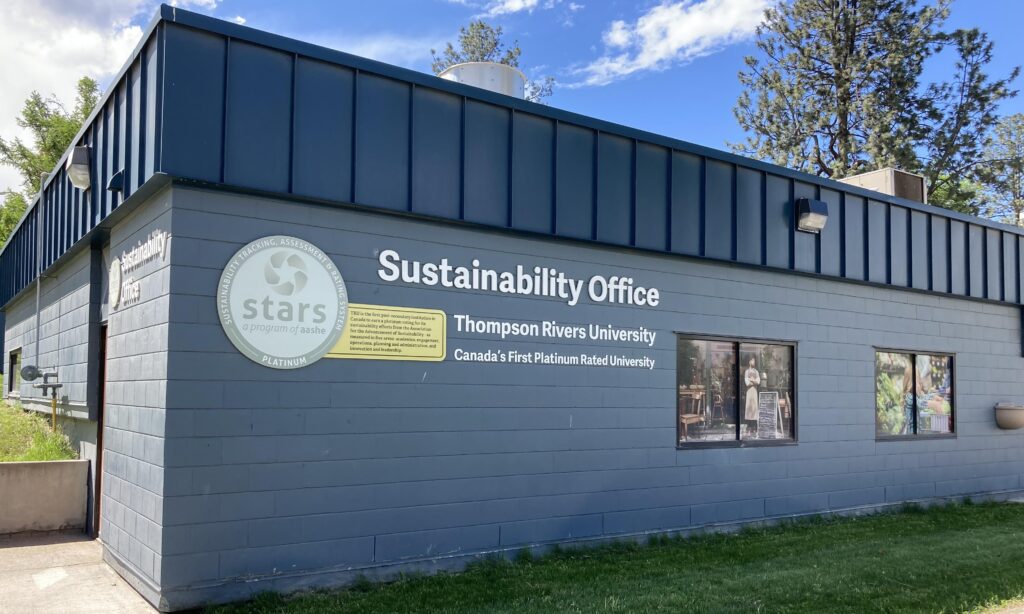
While the immediate financial benefits are difficult to quantify, Yao emphasizes the long-term perspective: “You have to consider the increasing price of GHG in the future. It’s just the right thing to do.” Gordon adds that the project aligns with TRU’s commitment to social responsibility and sustainable energy. BC Hydro’s cost displacement program has played a crucial role in financing the initiative.
TRU is strongly committed to reaching net zero carbon emissions by 2030; this solar panel project goes hand in hand with other larger projects that are in the works at TRU to reach this goal. Gordon confidently states that TRU is “very much on target to hit” zero emissions by 2030, positioning TRU “right at the top of the heat” amongst Canadian universities regarding sustainability efforts.
When questioned about future plans TRU has for sustainability, James and Natalie shared the district energy project that has broken ground on campus and set to be completed in the third quarter of 2026 that has the power to heat all the buildings on campus as well as the condos and student residences, and how the solar panel project goes hand in hand with supplying energy for the district energy building. Aside from building projects, the TRU energy management program was just launched in the hopes of educating people on how to be more energy conscious in their everyday lives.
James Gordon’s confidence in reaching zero emissions by 2030 is strongly backed up by the imperative efforts TRU has made in recent years to amplify the importance of sustainability. These efforts have challenged other universities to match TRU’s pace in the race against climate change. With the solar panel project working in tandem with the upcoming district energy system. Natalie Yao’s words resonate beyond the immediate project: “It’s just the right thing to do.” In this simple statement lies the core of TRU’s mission—a commitment to responsibility that extends far beyond the bottom line. As the university powers forward with its green initiatives, it’s clear that TRU isn’t just preparing students for the future; it’s actively creating a more sustainable one for them to inherit.
References
Dawson, J. Castanet, TRU solar panel project to see 540 solar panels installed by March 2025. https://www.castanetkamloops.net/news/Kamloops/517492/TRU-solar-panel-project-to-see-540-solar-panels-installed-by-March-2025
Gordon, J. TRU sustainability manager
Yao, N. TRU energy manager
TRU Launches Insightful Law Podcast with Legal Perspectives from Practicing Lawyers in Kamloops
TRU Launches Insightful Law Podcast with Legal Perspectives from Practicing Lawyers in Kamloops
Thompson Rivers University (TRU) is broadening its commitment to academic innovation and community engagement with the launch of an exciting new podcast focused on law and legal practice. Officially titled The TRU Law Podcast, this podcast is a result of students with an interest in law who want to provide those interested in law a way of consuming content that sparks curiosity. The first episode of this podcast will be released on the 30th of November.
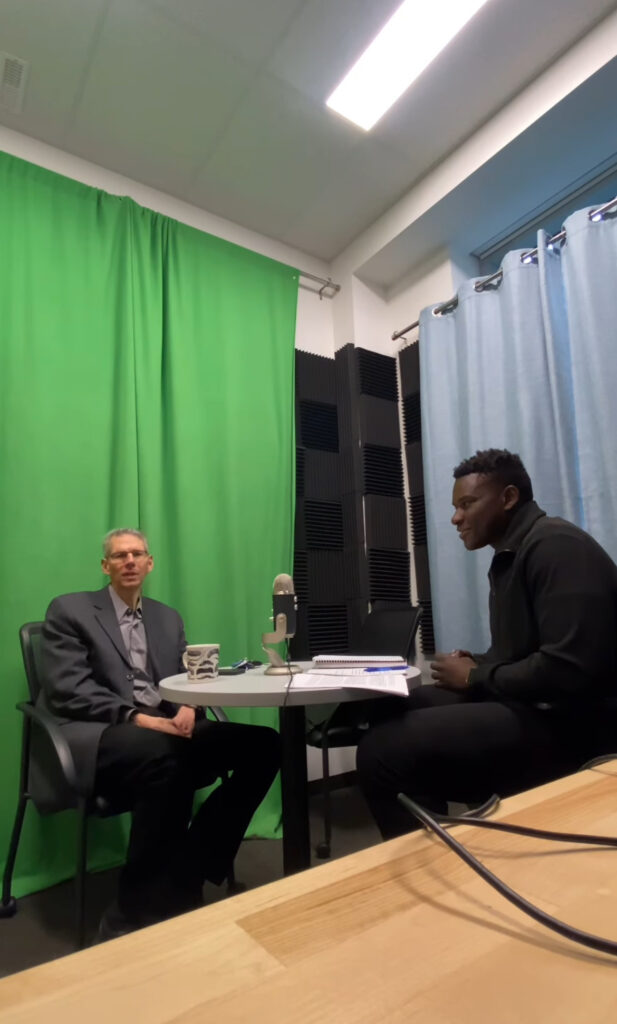
Image taken from The TRU podcast Instagram
When asked what inspired this passion project, the president of the TRU Law podcast, Ayomide Maxwell, said he was inspired by major law firms like McCarthy Tétrault, Norton Rose Fulbright, and Bennett Jones. Maxwell also shared that the initial goal of the podcast is to focus on recent cases and provide analysis from professors and local lawyers to make legal insight more accessible. With a good balance of perspectives from practiced lawyers in Kamloops as well as law students, the podcast will offer professional insight that is well balanced with academic curiosity.
The podcast serves to bridge the gap between the sometimes intimidating legal world and the world of everyday listening. As Vice President of the podcast, Millie Del Villano highlights, “There is a distinct lack of Law-related podcasts of this type.” Unlike other law podcasts, the TRU Law Podcast will be designed to make law more relatable and comprehensible for a broader audience. Filling a unique niche by presenting legal concepts in a way that is easy to digest for listeners who may not have any prior legal background.
A podcast offers students a unique and engaging way to digest what might be complex legal information, providing a fresh alternative to the formal law lectures students might otherwise have access to in order to learn about these legal concepts. The use of the podcast medium allows for more flexibility, allowing students to listen at their own pace, revisit key points as needed, or multitask while they are commuting, exercising, or relaxing.
Podcasts being s much more customizable experience, allows students to more seamlessly integrate learning into their daily routines. Which can allow podcasts foster a sense of intimacy and engagement that traditional lecture or lecture-like forms of information delivery may lack. Through informal discussions, humour, and reliable personal experiences that the podcast hosts add in the way they deliver their information, this can make the information more memorable and also create a sense of connection between the host and the listeners. This tone can help when presenting challenging legal principles, making them feel more approachable and relevant to students’ lives.
The podcast format also allows TRU Law Podcast to incorporate more recent real-world examples, which can be more impactful than older ideas and legal cases presented in lectures. Interactive elements like guest speakers or listener-submitted questions contribute to a more dynamic and participatory learning experience. Podcasts offer an innovative way to make learning both engaging and efficient. As Maxwell puts it, “Podcasts appeal to a tech-savvy generation that prefers audio content over traditional formats like books and lectures. They make legal knowledge more accessible and engaging.”
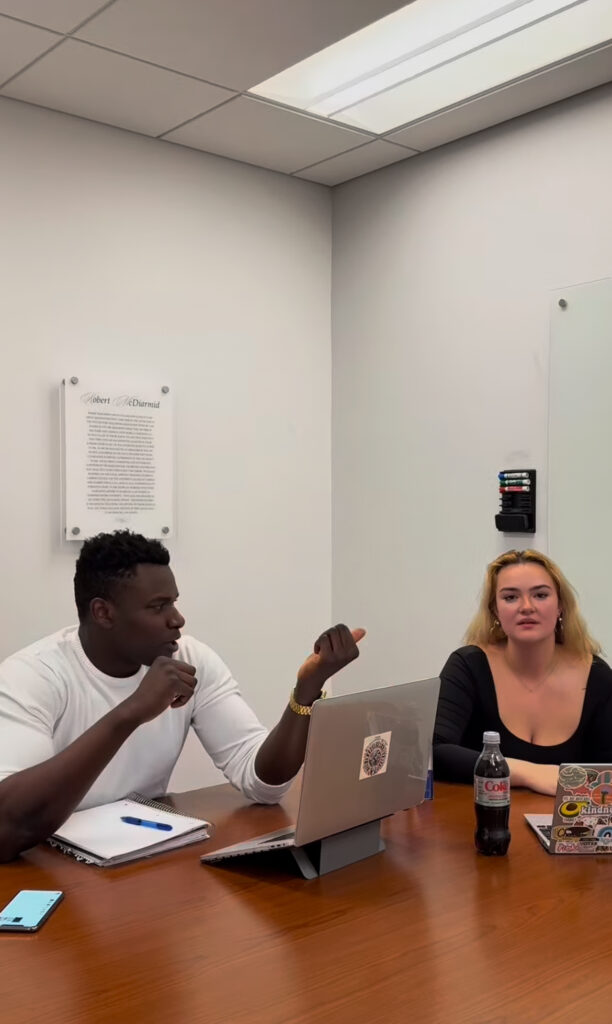
Image taken from The TRU podcast Instagram
When asked how the TRU Law podcast would stay up-to-date with recent legal developments to keep the content relevant, Del Villano said, “We are very lucky to have two amazing research VPs who are skilled at keeping up to date.” Maxwell also added that he is subscribed to newsletters that provide weekly updates on recent cases that he engages in conversation with lawyers across various practice areas, and is an avid listener of many well-renowned law podcasts.
The topics that will be covered on the podcast will be selected by an “executive team” that is composed of people with a passion for law who will pick content and topics that will reflect the interests of the student body. However, a core focus that will remain is that the podcast will be to summarize impactful recent cases. By summarizing recent cases, the podcast will keep students informed about developments that complement what has previously been covered in order to build upon what they have learned. By keeping students informed about the latest developments in law cases, the podcast can help students see how the theoretical learning they have been doing can be applied to real-world legal practices. Beyond law cases, the podcast will cover broader legal topics that resonate with the lived experiences of students.
Tenancy law, for instance, will provide insights into the rights and obligations of a landlord-tenant relationship, addressing common issues students may find themselves facing in their housing arrangements if they choose to live outside of the available dorms on campus. Similarly, immigration law discussions will cater to the diverse student body at TRU, offering practical advice on navigating visa processes, understanding residency requirements, and knowing the legal protections available to international students.
The TRU Law Podcast aims to empower students with the knowledge they can use in their personal lives, which would allow students to have a sense of preparedness in legal matters that concern them, whether they are aspiring legal professionals or those with a general interest in law. It will not only help to enrich the academic journey while attending TRU. The hope is that the podcast will improve the listener’s understanding of the legal framework in Canada.
References:
TRU Law podcast President, Ayomide Maxwell
TRU Law Podcast Vice President, Millie Del Villano
The TRU Law Podcast Instargam
Take A Trip to the Valley Markets
During the Christmas season, Kamloops has a variety of markets and craft fairs the community can attend. These events help promote local small businesses and local crafters in the Kamloops and surrounding areas.
The Valley Markets is one of the many markets that happens over the Christmas season. They host multiple events in the Sahali Mall over the fall, with 85% of vendors having booked a spot for the rest of the market’s season. They have a variety of small business owners at the event with a variety of products including self-care, crochet products, jewelry, artisan snacks, homemade clothes, knick-knacks and many more.
On Saturday November 16th, we spoke to Jasmine Thiessen of Charity Creations and Catrina McTavish of McTavish Designs. They are two separate small business owners who have experience at the market and talked with us about their experiences as small business owners.
Jasmine Thiessen runs a faith based small business called Charity Creations. She is originally from Brooks, Alberta and has just recently moved to Kamloops. She sells Christian based sweatshirts, glass tumblers and wooden nativity scenes. Her sweatshirts have a variety of bible verses, spiritual words and Christmas themes.
While she lived in Brooks, people would reach out to her for her products as there was not a lot of variety for apparel as a Christian, and what small amount there was did not appeal to a younger audience. She created very trendy sweaters that match the style of most people. She does recognize that it might not be for everyone but still wanted to make her own rendition on simple faith-based clothes.
Jasmine said her biggest struggle as a small business owner was finding her target audience. Over time she slowly figured out who she wanted her target audience to be and has created a variety of items that she hopes buyers will enjoy. She also said that the current economy is not as easy to work with for her business.
This is her first year at the Valley Markets and she had really enjoyed it. Her goal as a small business owner is to spread the Lord’s word to the community through her small business. She hopes to make an impact with her products as she continues to grow her business and attend more markets in the coming Christmas season.
Following Jasmine we talked to Catrina McTavish, a TRU law graduate who has created a business focused on unique jewelry. She is currently practicing as a lawyer while creating jewelry on the side. She uses semi-precious stones like quartz, jasper, agate and many more in her jewelry’s designs.
This is her second time attending the market, with her first time being back in 2021 while she was in law school.
“I really enjoy doing the markets,” Catrina said about being a vendor. “Talking to people and it’s very rewarding when someone comes and says ‘you make beautiful things’”
“It’s been a bit more difficult in recent times because of covid as people ended up not going out, not buying as much local stuff, ordering more things online. And on top of that obviously having some of the more handmade pieces that are a bit more expensive, it’s not as accessible monetary wise,” McTavish said, relating to how she’s found running a small business in Kamloops.
Her biggest struggles as a small business owner have been getting the word out and having people see her stuff as unique, as well as stuff not being seen as fast fashion and making everything seem uniform.
Catrina did have her jewelry for sale at The Art We Are on Victoria St in Kamloops, but no longer does. “I felt like I was sort of part of the art community trying to have other artists supporting other artists, and sort of having the community come and spend on the smaller businesses that have a little bit more unique things to offer.”
When asked for their advice, both small business owners gave similar answers to people thinking about starting a small business
Jasmine Thiessen said to, “just do it. Put all your time and energy into it and just see what works, see what doesn’t. Connect. It pays to know people. Most of the time, what you are doing is pretty niche but you will find that community, you just gotta advertise, branch out more and all that.”
Catrina McTavish had a very similar message. She said, “just give it a go, like you know it’s not even a big thing for me, I don’t really have anything besides my Instagram page and I kinda just do it on the side. I would just say, just stick to it, just put yourself out there. Take the risk, and take the small wins if they are small, just go with it.

You can follow Catrina McTavish on Instagram, @mctavish.designs.by.cat.
There are many more opportunities in the upcoming weeks to attend the market. With upcoming dates on:
- Saturday, November 30th
- Saturday, December 7th
- Saturday, December 14th
- Saturday, December 21st.
The market runs from 10 am to 3 pm at the Sahali Mall. Jasmine Thiessen said she will be at the market again on November 30th, and Catrina McTavish will be back on December 7th. If you have any questions about the Market or are a small business looking to promote yourself, there are multiple social media platforms under @valleymarkets for TikTok and Instagram and Valley Markets on Facebook. They also have a page on the Tourism Kamloops website with information on the event and future events they hold.
Bobby Helms – Topic. (2019, March 14). Jingle Bell Rock [Video]. YouTube. https://www.youtube.com/watch?v=Z0ajuTaHBtM
TRU Wellness Centre and Kamloops Mental Health Team up to Support Student Well Being.
Thompsons Rivers University’s wellness centre has a group of participants and volunteers that is making a significant impact on the wellness of its students through workshops peer led support and specialized training which is Naloxone training as well as counselling and along with Kamloops mental health and substance use is offering students an inclusive space to deal with university and everyday challenges.
Chelsea Corsi the wellness coordinator of TRU’s wellness centre stresses their presence and impact on the wellness and support to the students stating that “We have a hangout, kind of homework, play game area. We have our, like, kind of cat kitchen area where you can have a microwave. We have free tea. We also do naloxone training, we kind of provide a holistic package of different health resources for students”.
She says that from their research conducted through surveys and other statistics its seen that mental health is the biggest struggle that ranges from feeling anxious, seasonal disorders and loneliness. She added that “students are working more hours now than before due to the rise of inflation”.
Consent Tea an initiative and work group organized by TRU wellness center that emphasizes the importance of consent and communication in relationships and self-advocacy. For instance,
Feedback is done by collecting statistics The center collects student feedback, such as over 8,500 drop-ins last year which is based on the report collected from the number of checkups with the wellness centre assistant and uses a feedback tool to gauge student satisfaction. The center has many regulars, indicating success. The TRU mental health awareness also has another way of assessing the students responses and feedback after their assessment and support provided to students and which is a set of stickers that are offered to them such happy face, sad face and a meh face and its reported that most of the feedbacks received are happy face and hence the measurement of success of the wellness centre and its services.
In 2021, Thompson Rivers University Student Union ranked the center as one of the top outstanding services on campus based on student feedback, indicating strong positive responses from students. Chelsea also says how they hire the volunteers for the centre as each volunteer or interested participant goes under a training which involves learning about mental health which involves knowledge about stress in school, workplace and relationships as well as naloxone training. After the training each trainee is sent a set of nine questions for a reflection of their learning which is about what they have learnt about the role, what they like about the role and what they would have liked more to learn in the training that worked and which they think wasn’t covered and finally a reflection is provided to Chelsea. Peyton who is one of the volunteers at the wellness centre first assess a student and then Chelsea spends almost two hours in synthesizing the information which is then shared with the team and is three-page written feedback and is reviewed together for almost forty-five minutes. Finally, after all the assessments and feedback from her team a student is then given a report and suggested on the areas that needs to be looked more into and solved and then the support and counselling is given.
Nicole Hagan from Kamloops Mental Health and Substance use says that “students facing severe substance use concerns are referred to where TRU students undertake an assessment to create individualized treatment plans off campus”.
A student must complete an intake assessment provided in the facility to facilitate the formulation of recommendations and a treatment plan, encompassing both their services and those available in the community. This process is contingent upon the individual’s mental health and substance use status.
If a TRU student presents with a substance use issue, they have access to all relevant services and programs for which they qualify, except for mental health services, as these are provided through the counselling department at TRU. Students experiencing depression or mood disorders will be sent to TRU counseling. According to Nicole from Kamloops Mental Health and substance use said that they see a very few drop in from TRU students regarding drug abuse while on contrary receive more students with issues such as suicidal thoughts and relationship issues which they again send to TRU Wellness centre for counselling and support.
Kamloops Mental Health & Substance use provides drop-in hours with a clinician accessible for assessments. They provide many group programs available to TRU students. Numerous TRU students are sent to mental health group programming that addresses drug use, and assists TRU students experiencing a psychotic break, which differs from substance use. The mental health groups specifically focus on psychosis, a state where a person finds difficulty in realizing what’s real and what is not.
So, from providing relaxing areas to peer-to-peer interaction and with services that allow one to get free from addictions and mental stress Kamloops Mental Health and Substance use are here at the forefront to support student success and well-being.
Reference:
- TRU Wellness centre (Chelsea Corsi)
- Kamloops Mental Health & Substance (Nicole Hagan)
Exploring Kamloops’s remarkably high crime rates and uncovering what the city is doing to combat them
According to Statistics Canada, last year, Kamloops had the highest crime rates in Canada for communities with at least 100,000 people. This statistic is majorly alarming for locals, tourists, and people looking to move here. Understanding what the Kamloops police and community are doing to combat this issue will help to build better trust and cohesion between the police force and locals. Highlighting useful resources and safety precautions that community members can employ to protect themselves and their property is an important first step to tackling this greater issue.

(RCMP responding to an incident, Photo by Michael Friesen)
Statistics Canada states that Kamloops crime rates are 115% higher than the national average, and violent crimes are 61% higher. While violent crime rates are alarmingly high, Statistics Canada states the most common form of crime in Kamloops is property-related. This means damage, theft, or vandalism to personally owned property like housing and vehicles.
The city and RCMP have stated their opinions on the matter, Mayor Reid Hamer-Jackson said, “The figures for the city are not surprising, but I’m concerned that they are going to scare people off.” A common argument against the high crime statistics from notable city officials and RCMP members is that the numbers can look large due to the small size of Kamloops compared to most other cities on the Statistics Canada list. Bryan Kinney, a criminology professor at Simon Fraser University states the high rates “shouldn’t be a cause for alarm.” And that “as communities — like Kamloops — approach the 100,000 population mark, they start to see more “big city” activities, such as more business investments, as well as more crimes.”
Although these arguments are important to consider when analyzing the crime issues in Kamloops, they don’t dismiss the alarming statistics that have been published on the matter. An important thing to consider when examining Kamloops’s crime statistics is incidences that were not filed with the police or the city. As crime becomes more common, community members may feel helpless or feel as if filing a report is useless. The crime statistics only account for reports that have been filled. This large discrepancy may mean that the issue is larger than expected.
Although the matter can seem concerning, preventative measures are in place. The Kamloops Crime Prevention unit sanctioned by the city aims to educate and spread awareness on the topic. They have various volunteer programs throughout the city aimed at preventing crime. The city website highlights The North Shore Community Policing Office, where they “deliver crime prevention and community safety programs for the entire community, which provides an important link between the city’s police force and the community. In addition to general policing, this station houses the Kamloops RCMP’s Auxiliary Constable Program and the Crime Prevention Section, which operates the Restorative Justice, Crime Watch, and Speed Watch programs, among others.” Programs like this are fundamental steps that the city and community must take in order to combat the high crime rates in the city. These initiatives build relationships between city members, RCMP officers, and the community, and will foster collaboration and effectively spread awareness.
In an interview, the Kamloops Crime Prevention Coordinator stated “Our RCMP does a great job managing crime, a community based preventative measure that is highly effective is the Crime Prevention Request page on our website.” Using this feature, community members can file a request for crime prevention by stating a location or business that they think needs more help or attention, the city will then look at these requests and working with the RCMP they may dedicate more resources to that location. Using this feature gives the community a voice on the matter, it allows collaboration which in turn, creates a safer environment altogether.

(Homeless individuals sleeping in -2°, Photo by Michael Friesen)
Another important variable to consider when looking at crime in Kamloops is the issue of homelessness. The City of Kamloops states that “over the past nine years, Kamloops has seen an over 200% increase in the number of unhoused individuals identified in Point-In-Time Counts.” It’s apparent that the issue has become a serious consideration. The city also stated that “on April 12, 2023, the shelter was at 95% occupancy.”
This puts the issue into perspective. While homeless rates may not have a direct correlation with crime rates in the city understanding the effects homelessness can have on them is important. Drug-related issues are common among the homeless, and with the high homeless rates that are present in Kamloops, there will inevitably be drug-related charges that come with the high population.
An effective form of crime prevention that is used by the city and businesses is security. Security can help deter and protect property during late and vulnerable hours of the day. This measure is essential to combating crime in the city. The police force does not have enough resources to protect every business and location at any given time, this is where security provides its high value.
Ryan Anderson the Director of Operations at Paladin Security in Kamloops states “We provide protection and reassurance to select businesses around the city, our most effective form of crime prevention is patrolling and stationing.:” When individuals and business owners opt to utilize security, they are purchasing reassurance. In almost every case, the presence of a security officer is enough to deter would-be crime.
This is just one of the ways in which the community, city members, RCMP, and business owners can collaborate to tackle the issue of crime in the city. As long as the city continues to dedicate resources towards crime prevention and homelessness and continues to foster initiatives the community can take part in through volunteering, the city will begin to feel safer and more united.
Early Childhood Education at TRU

A world without Early Childhood Educators would be quite drastic. The future of our children is highly dependent on the foundations of their learning and education. Unfortunately, British Colombia is experiencing a shortage of early childhood educators, which is quite concerning. There are various reasons why there is such a low supply of early childhood educators, such as staffing issues, child care spaces, recruitment and retention.
There are many challenges that early childhood educators face in British Colombia. Some childhood educators may earn well below the provincial living wage, therefore making it difficult to retain skilled professionals. With the high cost of living in Canada, it seems unreasonable to invest in years of education, only to struggle to make ends meet. Furthermore, educating and taking care of children can be very physically and mentally demanding. Being an early childhood educator involves long hours and very limited recognition which can result to being burnt out. Lastly, there isn’t a lot of funding or sponsorship programs to help program developments and resources for early childhood educators.
Fortunately, an anonymous donor will contribute $1.4 million over three years to the Peer-Mentoring Program, which was founded by Professor Doctor Laura Doan of Thompson Rivers University in collaboration with ECEBC. The Ministry of Children and Family Development has also given ECEBC $500,000 to improve the program over the next three years.
By enhancing ECEs’ capacity, meeting their continuous needs for professional identity development, raising their levels of teacher-efficacy, and fostering greater confidence in their teaching abilities, it seeks to broaden the current support system and reduce the number of ECEs quitting the field.
Such opportunities that are presented by Doctor Laura Doan help to address the challenges that Early Childhood Educators face. These opportunities create opportunities for peer mentorship programs that create pathways for experienced educators to mentor newcomers and this provides support, reduces burnout, and can improve retention. Also, funding from the anonymous donor will help to increase wages, provide proper resources and make the career more attractive to future applicants. Lastly, the peer mentoring program will definitely help with community involvement because such collaborations can help to foster knowledge sharing and advocacy for Early Childhood Educators.
Moreover, peer mentoring programs provided by TRU will not only benefit Early Childhood Educators. It will also benefit children and families by providing better educational outcomes for children and it will help create reliable childcare services by reducing stress for families. Additionally, it will help the Kamloops community as whole because it will create a stable and robust workforce in the early childhood education sector. There is a lot of external influences that are rapidly affecting the cities development and that can certainly trail to the children of the community. Providing opportunities like these, can help ease social anxiety and interactions within children that will help them make the right decisions for the foreseeable future.
Please note that my interview with Doctor Laura Doan and a student in the early childhood department is scheduled for Thursday and Friday. But below are possible interview questions that I would ask.

Questions and responses from Doctor Laura Doan
How do you think the TRU Peer Mentoring program helps build a stronger, more collaborative early childhood education community in BC?
“The TRU Peer Mentoring program fosters a sense of community by connecting educators who share experiences and best practices. This collaboration leads to a more supportive environment, which ultimately enhances the quality of early childhood education in BC.”
Do you think peer mentorship in the early childhood education sector could be a model for other fields in education or in different professions? Why or why not?
“Absolutely, peer mentorship can serve as a model in other educational fields or professions. It encourages knowledge sharing, builds networks, and helps individuals feel less isolated, which is beneficial in any career.”
What were some of the biggest challenges you faced when you first started working as an early childhood educator?
“One of the biggest challenges I faced when I started was managing the diverse needs of children while also keeping up with administrative tasks. It took time to find that balance.”
What are some common challenges that new educators face, and how do you help them navigate those challenges?
“New educators often struggle with classroom management and feeling overwhelmed. I help them by sharing strategies and providing emotional support, creating a safe space for them to express their concerns.”
How long have you been involved in the program, and how has it impacted your own teaching practice?
“I’ve been involved in the program for a few years now, and it has significantly influenced my teaching practice by encouraging continuous reflection and growth.”
How do you measure the success of the program? Are there any key outcomes or metrics that you track?
“Success can be measured through feedback from participants, improved teaching practices, and ultimately, positive outcomes for the children in our care. We track engagement levels and satisfaction surveys.”
How do you think TRU Peer Mentoring addresses the issue of educator burnout and mental health in the early childhood education field?
“The TRU Peer Mentoring program addresses educator burnout by providing a support system where educators can share their struggles and find solutions together, promoting mental well-being.”
First-Time Homebuyers Struggle in Kamloops Real Estate Market

The dream of owning a home has always been a symbol of stability and success for Canadians, but for first-time buyers in Kamloops, BC, it’s becoming increasingly out of reach. Rising housing prices, soaring interest rates, and an ever-growing cost of living have created a perfect storm that is locking many young families and professionals out of the market. What was once seen as a natural next step in life now feels like an impossible goal.
Joel Rodriguez, a real estate agent with Brennan Shaw Real Estate, sees these struggles every day. “Affordability is the topic on everyone’s mind,” he says. “Coming up with a down payment is the largest hurdle. Rent takes up such a significant portion of income that saving feels impossible for many.” Rodriguez explains that, for many people, just putting aside money every month is an overwhelming challenge. In Kamloops, the average price of a home has skyrocketed to $657,000 which is an increase of 170% since 2008. This price surge has exceeded wage growth, leaving homeownership out of reach for many residents.
Even with programs like the CMHC’s 5% down payment option, the challenges persist. While this incentive lowers the barrier to entry, it comes with mandatory mortgage insurance, which adds another cost to an already strained budget. For many, these programs feel like temporary solutions that fail to address the root issues in the housing market.
Interest rates only add to the complexity. Rodriguez points out that while today’s rates of 3.75% are lower than the double-digit rates of the 1980s, they still have a major impact on purchasing power. “Lower rates in the past gave buyers more flexibility,” he explains. “Now, even a small increase can push people out of the market entirely.” The combination of rising prices and higher borrowing costs has created a scenario where the idea of buying a home feels more like wishful thinking than a realistic plan.
For developers like Brandon Pittman, who owns Pittman Construction, the challenges begin long before homes even hit the market. The geography of Kamloops, shaped by hills and rivers, makes developable land scarce and expensive. “Land in Kamloops is constrained,” Pittman explains. “This naturally drives up prices because there’s less available land to work with.” Zoning regulations and lengthy approval processes only add to these issues. Developers often wait months or even years for projects to get approved, and these delays drive up costs.
Even when developers aim to build more affordable options, such as smaller homes or condos, they face significant hurdles. High municipal development fees and community resistance to higher-density housing make it difficult to get these projects off the ground. Pittman shares how initiatives like townhomes and duplexes often meet stiff opposition from residents who prefer to maintain the traditional single-family home model. “Without higher-density housing, affordability will remain out of reach for many people,” he says.
Government policies, while offering some incentive programs, haven’t been enough to address these systemic issues. Pittman points to development charges, which can add tens of thousands of dollars to the cost of a home, as one of the major barriers to affordability. While grants and density bonuses exist, they often don’t go far enough to offset the high cost of building in today’s market. Rising inflation has also pushed up the cost of construction materials, such as lumber and concrete, making it even harder for developers to deliver affordable housing.
For many people in Kamloops, the struggle to buy a home is more than just a financial issue, it’s deeply personal. Kamloops has always been an attractive place to live, offering the benefits of a smaller city while still maintaining a strong sense of community. However, as more people move to the area, competition for limited housing grows. Rodriguez explains that while this influx has helped the city’s economy, it’s also made it harder for locals to find affordable housing. “People want to live here,” he says. “That’s great for the city, but it’s creating a market where supply just can’t keep up with demand.”
Pittman adds that the rising cost of housing doesn’t just hurt buyers, it also affects developers. Higher interest rates mean higher borrowing costs for builders, which leads to scaled-back projects and further delays in housing supply. “We’re caught in a cycle,” he says. “The costs keep going up, so fewer homes get built, and the shortage drives prices even higher.”
Despite these challenges, both Rodriguez and Pittman believe there are solutions. Pittman suggests building smaller, more energy-efficient homes and streamlining the development approval process to make it easier for developers to deliver affordable housing. He also advocates for incorporating more townhomes and condos into new developments. “We need to think about practical solutions,” he says. “The current system isn’t working for anyone.”
Rodriguez agrees and sees potential in government-supported initiatives like land trusts and equity-sharing programs. He stresses that homeownership is more than just a financial goal, it’s a way to build long-term stability. “We need policies that give people a real chance to own a piece of their community,” he says.

However, these solutions require a change in mindset from both policymakers and the public. Pittman emphasizes that community support is essential. Without it, every proposed development risk’s being derailed by opposition. “We need to think about the bigger picture,” he says. “If we keep blocking higher-density housing, we’re only making the problem worse for future generations.”
For now, the gap between the dream of homeownership and the reality of the housing market in Kamloops continues to grow. Young professionals and families face difficult decisions. Should they continue saving for a dream that feels increasingly out of reach, or should they move to areas where housing is more affordable, even if it means leaving behind their community and support networks?
Rodriguez remains cautiously optimistic. He believes Kamloops is a resilient city, but he also knows that real change will require effort and collaboration. “If we want Kamloops to stay vibrant and inclusive, we need to tackle these challenges head-on,” he says. “Everyone deserves a shot at owning a home.”
As the struggle continues, the faces behind the statistics become harder to ignore. These aren’t just numbers, they’re families, young professionals, and long-time residents who are being priced out of their own city. The question is no longer whether Kamloops will rise to meet this challenge but how soon it will act before the dream of homeownership fades entirely.
Attached below is the video interview with Joel Rodriguez.
TRUSU Makes Plans to Host the 2025 International Women’s Day Event
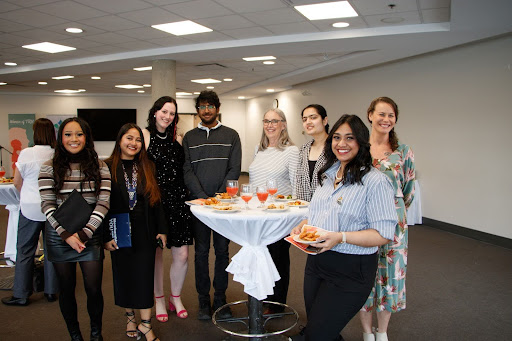
Since 2019, the Thompson Rivers University Student Union (TRUSU) has awarded dozens of women with the “Women of TRU Award”. This award has grown immensely over the years and now includes an event for people to connect over these achievements. March 8th, 2025 will mark International Women’s Day and TRUSU is ready to give seven outstanding women the platform to share their message and give a donation towards a charity of their choice. The charities are chosen by the women and TRU has graciously given each charity 500$ to use how they please.
“This award gives women the opportunity to learn and grow while giving those teachings back to the next generation” states Shannon Lopes, 2023 TRUSU Members-At-Large for the equity committee.
2023 marked the year that this award had expanded from an online recognition to an in person event. The TRUSU Equity Committee decided that this award should be followed by a luncheon and a charitable donation. With over 50 enthusiastic individuals in attendance last year, the new committee hopes to have a greater impact on the community at the next addition of this event. The luncheon included the 7 recognized winners, each giving a 2 minute speech in thanks to the nomination as well as each of the 7 charities present to accept their cheques. The speeches were very impactful, making people laugh, cry, and understand the importance of women in their respective fields.
“It’s a huge honour in particular because I came from TRU. I did my undergrad here quite some time ago so to actually have members of the student body nominate and elect me for that kind of an award was huge” states Dr. Amie Mclean, award winner of the Women of TRU in 2024.
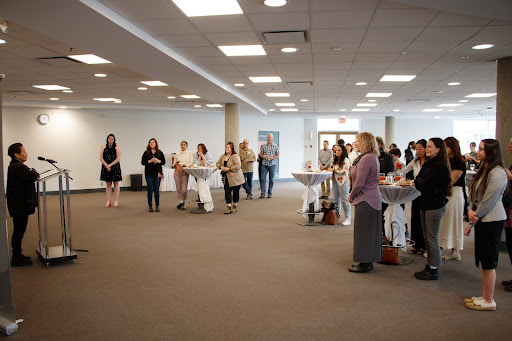
This year’s event is already in the planning stage. With nominations underway, TRUSU is aiming to have as many women nominated as possible. Students are encouraged to submit their nominations before December 31st, 2024 so the committee can then begin deciding which 7 women are going to be selected. These 7 women will then go through an interview with the committee members to create an article for publication. The interview is an opportunity for the committee to get to know the women better and ask them questions about their charity, degree/career, impact on the community, and future goals. These articles aim to share how many influential women are present on campus and break barriers to inspire the next generation of women at TRU.
“Hundreds of applications come through our selection committee for this nomination and it really goes to show that there are many amazing women here at TRU. We carefully choose 7 of these women to be our winners and begin with our interviews” states Shannon Lopes.
March 8th, 1975 represents the first ever International Women’s Day recognized by the United Nations. With the goal of recognizing and celebrating women’s achievements, International Women’s Day is recognized alongside the labor movements of North America and Europe throughout the twentieth century. Since the beginning of this celebration, women’s rights movements have come a long way in societies all across the globe.
“I am both empowered by being a member of a huge community of folks who are really fighting for those things but it is hard to witness some things both institutional and in the broader global/political context” States Dr. Amie Mclean when asked about the progress seen by the women in TRU
“Coming from another country to Canada, it is amazing to see the progression in women’s rights here. I love to see another angle of feminism and I hope that many women can learn from this opportunity” states Shannon Lopes.
Dr. Amie Mclean is a strong advocate for EDI related issues. As a faculty member at TRU and a TRUFA committee member, Dr. McLean works tirelessly towards progression at TRU. In March of 2024, Dr. McLean had won the Women of TRU award for her ongoing work towards the betterment of TRU. During her impactful speech, she dedicated her win to her son who lives with many medical conditions. As a mom, caregiver, and faculty member, Dr. McLean goes above and beyond for those around her. She chose to donate to People in Motion: an organization that aims to work with people with disabilities to help them feel included.
“People in Motion has an active commitment to ensuring that folks with disabilities have the opportunity to go out and participate as full members in the local community… The reason I have chosen them is because I am the child/ parent/ sister/ aunty to folks with disabilities and in particular my son has spinal cord cancer and spinal cord injury so this is something that is very near and dear to my heart” states Dr. Amie Mclean.
Found on the TRUSU webpage, students can find the nomination form and select any women on campus who deserves recognition. From faculty and staff to students, anybody in the TRU community is eligible to be nominated. The criteria are as follows: Female identifying TRU student,staff or faculty excluding TRUSU members and have not won the award previously. The selection committee will be looking for a woman who has left an impact during her time at TRU and continues to be an inspiration to the people around her. This woman will be given a platform to share her message as well as give back to the community. This event opens opportunities for people to become inspired by the award winners as well as open networks for them to find resources and opportunities best suited for them. This event has news press, government officials, and other influential community members who all come together to celebrate the achievements of women.
When it comes to the betterment of the students and community, TRUSU aims to put their best foot forward. With this event approaching fast, students and community members are encouraged to get involved, nominate, and commemorate the amazing women of the TRU community. With the official date of the luncheon to be determined, keep an eye for the early month of March for International Women’s Day and the tentative dates.
International Students struggle in Kamloop’s challening job market
Canada has become a prime destination for international students looking for higher education and experience both personal and professional while beginning their adult lives away from home. Filled with great opportunities such as jobs and education have attracted students from all over the world. Kamloops specifically stands out due to Thompson Rivers University’s variety of programs, great campus and work opportunities in the city. Many students are excited to jump into a new community, as they try to find part time jobs to support themselves and gain experience. However, finding employment in Canada is not easy, especially given the current job crisis. More and more students continue to struggle to find jobs during the crisis; internationally students are specifically affected as the new environment makes them feel out of place and make it harder to be noticed by employers. Help is always needed when trying to find part time positions; students need support from TRU in order to feel at home.
International students face unique challenges in a competitive market where employers often prefer local candidates with local knowledge and experience. According to Hanson (Unemployment crisis grips Canadian international students, prompting concerns over immigration policies, 2024), the unemployment rate among Canada’s youth as of March 2024 is 12.6%, reflecting the tough conditions for job seekers, particularly international students. In Kamloops alone, according to TRU’s website there is an approximate of 7,757 international students from 122 countries (TRU at a Glance 2023-2024, 2024). Students must master key job searching skills such as; navigating websites, preparing for interviews, and crafting strong applications. A great majority of students are new to this whole process and may stumble during it which might lead to their struggles finding a job no matter their skills, all because they aren’t prepared for the whole process.

Searching for jobs can be scary and overwhelming, especially for new students adapting to a different country and culture. Andrea Castro, a third-year biology student from El Salvador, shares her experience in Kamloops’ job market. Since she arrived in Canada, she has had three different jobs but faced many challenges each job search. Over the years, she has submitted more than 40 applications to various companies, both online and in person. While reflecting on her job search she said:
“Sometimes, depending on the season, it’s good to find jobs as there’s more availability. Other times, it’s harder.”
Schedule conflicts add a new layer of difficulty to students when trying to find a job that best suits them, this can fluctuate based on the semester. Balancing coursework, exams and activities limits the jobs they can apply to. Employers often prioritize candidates with a more flexible schedule, putting students like Castro at a disadvantage. There are many roles in Kamloops as full-time positions, giving students fewer options to choose from. Castro shares her experience as she has had a considerable amount of experience in searching for jobs here in Kamloops, a place limited by its size where opportunities are finite. Students trying to find a job can become unmotivated by the constant rejection and not hearing back from jobs. TRU offers valuable resources to support students. The university’s Career Services department provides mentorship and practical tools to guide students through the job search process. Castro recalled her first job interview experience in Kamloops:
“For my first job, I was not prepared at all. I didn’t know what to expect because it was my first interview.”
Castro’s first time in an interview is described as a struggle where she felt she wasn’t prepared and felt anxious during the interview as she felt she didn’t know what to say with each question. With time Castro became more confident when it came to job interviews.; she described her most recent interview:
“For my last interview, I was prepared because I knew what to expect from the company and what they wanted. They hired me based on my personality.”
Larry Iles, Experiential Learning Coordinator and Associate Teaching Professor at TRU, highlights the comprehensive support offered by Career Services.
“We run monthly workshops on resumes, cover letters, and interviews. Plus, we know thousands of employers, so we have a big network and know what they’re looking for.”
The different workshops throughout the semesters are filled with helpful information that can guide students to have an idea of how the job search process should be. The student’s inexperience, despite these resources, can lead to common mistakes in their job search. Iles notes that many rely too heavily on job search platforms like Indeed:
“Students assume that because they took courses in a subject, they know a lot about it, but they haven’t worked yet. The world of work is completely different from classroom theory. Relying solely on Indeed is the worst thing you can do. When a job is posted there, they get thousands of applicants within an hour.”
Iles emphasizes the importance of networking and exploring diverse job search strategies. Leveraging TRU’s Career Services, connecting with professionals, and applying creatively can significantly enhance students’ chances of landing jobs.
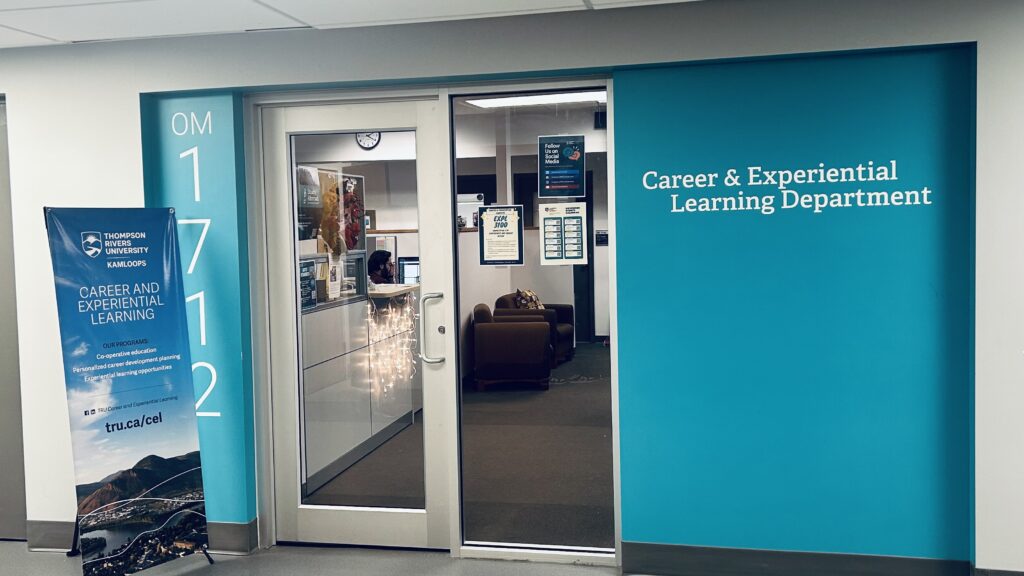
The job search can be a frustrating and overwhelming journey, especially for international students with limited experience. However, with the right guidance and persistence, they can navigate the market successfully. Larry Iles encourages students to use the resources they have here at TRU in the Career Services department located at Old Main 1712, as they have all the options available to help them prepare their resumes, cover letters, and have some tips and tricks for their interview process. Career Services is a flexible resource that can help new or seasoned students that know their way around in Kamloops to reach the job position they dream of both part time or full time. TRU’s Career Services remains a great tool to help students build confidence and secure employment that best suits them.
Check out our interview with Andrea Castro to learn more about her experience searching for jobs.
References
Hanson, L. (2024, April 29). Unemployment crisis grips canadian international students, prompting concerns over immigration policies. Crystaledunews.com.ng. https://crystaledunews.com.ng/unemployment-crisis-grips-canadian-international-students-prompting-concerns-over-immigration-policies/29/#content
www.tru.ca, T. R. U. (2024, May). Facts and figures: Integrated planning and effectiveness. Thompson Rivers University. https://www.tru.ca/ipe/facts-and-figures.html
Cutting the Lines: Sun Peaks’ New Chair Lift Brings Speed and Adventure to the Slopes

Mark your calendars for November 16th, Sun Peaks Resort is rolling out an exciting new feature for skiers and snowboarders with the opening of a brand-new chair lift. Set to enhance skier flow, reduce wait times, and provide quicker access to challenging runs and stunning alpine views, the new lift is expected to be a game-changer for both locals and tourists. As one of Canada’s largest ski areas, Sun Peaks is constantly working to improve the visitor experience, and this most recent improvement is expected to solidify its standing as a top winter sports destination (Jacklyn Kearl).
Speaking with Dylan Benson, a staff member of three years, and Jacklyn Kearl, a senior leader at the resort, provides insight into what this lift means for the ski community and how it will transform the mountain experience.
When asked if the new chair lift would attract more visitors, especially during peak season, Jacklyn Kearl was confident “Absolutely by improving lift efficiency and reducing lines, we’re offering a much smoother experience”. Sun Peaks has already received positive feedback from the community and believe this will lead to more word-of-mouth recommendations and repeat visits.
Kearl explained that Sun Peaks is often very busy during holiday periods and weekends, with long wait times being a common issue. The new lift, along with three additional ski and snowboard runs, will ease that congestion and make the resort more appealing to both regulars and first-timers. “Everyone’s excited,” Kearl added.
Of course, any large construction project comes with its challenges (Jacklyn Kearl). Kearl mentioned that unpredictable weather conditions and delays in approvals were obstacles the team faced. “It was tricky at times, especially dealing with weather, but we’re thrilled to finally open the lift on November 16,” she said. Although there’s no official grand opening event planned for the lift, the excitement from the community is outstanding.
Sustainability played a crucial role in the lift’s design and construction. Kearl emphasized that Sun Peaks takes care to minimize its environmental impact. “We worked to install the lift in a way that reduced deforestation” Kearl said. The lift also features energy-efficient motors and is exploring renewable energy sources to power its operation. These measures reflect the resort’s ongoing commitment to balancing development with environmental responsibility and a growing concern for the tourism industry.
Dylan Benson, a longtime employee at Sun Peaks, was equally enthusiastic about the new addition. “This lift is going to make a huge difference,” Benson said. “It’s been frustrating for skiers to wait in long lines, especially on the busiest days” (Dylan Benson). With this lift, lines will be able to move more quickly, giving people more time on the slopes.
Benson, highlighted that the new lift will provide greater access to advanced runs, offering more opportunities for experienced skiers. He emphasized that the expanded terrain will appeal to those looking for a more challenging and adventurous experience.
Dylan Benson, who provided exclusive photos of the new lift and the spectacular views it offers. Also captured some video footage of the lift and its surroundings, bringing the story to life for readers who want to see what’s waiting for them this season at Sun Peaks.
The addition of this new chair lift is more than just a technical upgrade, it’s a significant development for the entire ski community. As Sun Peaks continues to grow as a tourist destination, this lift addresses one of the main challenges: congestion during peak times. By making it easier for visitors to access the mountain’s most sought-after terrain, the resort is improving the overall skier experience, which is likely to attract more visitors and boost the resort’s reputation. With the opening just around the corner Sun Peaks Resort is ready to kick off the season with this new efficient lift, offering skiers and snowboarders a faster way to hit the slopes.
Sun Peaks Interview with worker Dylan Benson:
COVID-19 Online Learning Impacts on Elementary School Students
The COVID-19 pandemic online learning brought many challenges for young children in elementary school, impacting learning, social interactions, and physical capabilities. Primary and intermediate teachers Joanne Reilly from McGowan Park Elementary and Kim Hindle from Pacific Way Elementary witness the effects of online learning on young students and experience noticeable setbacks in students’ capabilities.
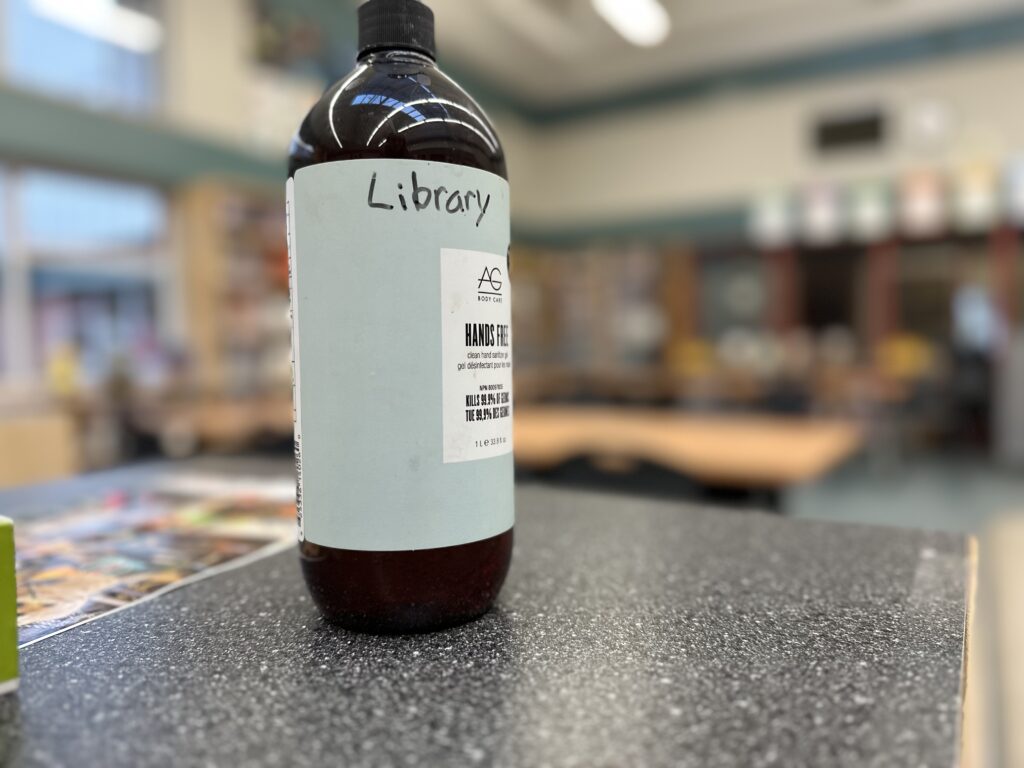
For many students, the transition from online learning back to in-person was far from seamless. Students from kindergarten to grade one struggled the most with speech literacy, Reilly explained. This fundamental skill of language and communication is the stepping off point for many essential competencies such as spelling, reading, and writing.
During the period of online learning, students were not able to practice communicating with peers, creating learning gaps when returning to the classroom environment. Reilly noticed a significant learning gap in her classes post Covid-19 as opposed to pre-Covid-19, saying, “home learning might have impacted students because they are not interacting with peers as much.” Reilly suggests that at the kindergarten and grade one age, “a lot of learning is from playing and interacting” creating language efficiencies and communication skills. The lack of in-class socialization leads to language gaps when returning to the classroom environment.
The lockdown created challenges when returning to school and dealing with independence and problem solving. Reilly sees that many children come to teachers or leaders first without trying to solve a problem on their own. Reilly notices that some students struggle to “[do] things independently, and [try] things on their own, and problem [solve],” suggesting students, “are not as prepared to or haven’t had that opportunity to do that before.” With other resources accessible during home learning, students struggle to solve problems without leaning on those tools. These skills are important to allow for the progression of communication and learning habits.
Students practice classroom social skills that will attribute to future subject learning. Reilly expresses that “learning skills such as sitting nicely, and stopping, and looking, and listening, [have] been something that seems to be more and more challenging for students to learn … and are all those kinds of things that you almost take for granted that they would be able to do before they get to kindergarten and grade one.” These social skills not only support classroom engagement but allow for future success in learning. Children at this age are learning to learn and these fundamentals are the pre-cursors for many educational milestones that will lead to other subjects.
Online reading programs, online websites, Google Classroom, Chromebooks, iPads and other tools helped to enhance students’ learning during the pandemic and have continued in classrooms today. Reilly says that prior to online learning, technology was not as utilized to the extent it is today, saying “I am now using different reading programs so that I can work with small groups and give them something valuable and exciting.” Teachers are more comfortable integrating technology into the classroom environment and utilize it to assist students who require additional one-on-one learning.
Reilly notices that students are more intuitive and instinctive when working with technology, however fine motor skills may have declined since online learning. Holding a pencil to write, turning pages, or playing with smaller toys can each be actions that are conducted differently when using an iPad or computer.
During online school, many young students’ learning depended on their family situation. Some parents had the opportunity to be very involved in their child’s education whereas others may not have been in a position where they were able to provide educational support on a daily basis. This meant that some children were affected more significantly than others, creating more diverse levels in future grades.
In intermediate grades from four-seven, Hindle notices significant changes in learning styles and abilities. She says, “kids have less perseverance and are way better at ‘black and white’” meaning they will excel with simple adding rather than a math problem. Hindle acknowledges that many students struggle with “anything that requires higher level thinking, perseverance, or hard work.” Hindle suggests that the lack of problem solving, and critical thinking today can be attributed to the addiction to technology created during online learning as it allowed students to access information easily.

The lack of socialization and focus during online learning left many students deprived of effective learning habits and social routines. Hindle says that “social skills have declined massively, and [students] need to be entertained” even suggesting she is there to be a clown, not to educate them. This demonstrates the lack of focus that many students today display. The online learning period and current constant accessibility to technology is creating learning gaps in classrooms today.
Without structured daily activity that schools provided, an increase in sedentary lifestyles among children is assumed. However, both Reilly and Hindle suggested that any difference in physical capabilities was less derived from online learning but from family tendencies. Families who were active remained active, and kids who were watching TV and gaming, continued to watch TV and game. According to the study conducted by Colley and Saunders suggests that “physical health is a key determinant of health and youth who engaged in more physical activity and sleep while reducing screen time during the pandemic had lower depression scores, less severe emotional dysregulation, and better subjective well-being” (Colley and Saunders, p. 4, 2023). The family lifestyle that students experience contributed to their learning habits. Hindle suggests it is difficult to pin-point whether online learning had a significant impact on students’ physical capabilities.
The adjustment to and from online affected how teachers conduct their curriculum. Hindle says the integration of technology in classes “forced some growth in [teachers] who maybe didn’t want to do that growth” and it benefited her and other teachers still today. To accommodate drastic learning gaps, Hindle produces assignments for multiple levels. She says, “everything that I plan, I have different levels, so I have beginning, middle and a challenge level.” Hindle assigns project-based work for other subjects that allow students to go as detailed as they can or want allowing achieving students to demonstrate their learning, while providing support for students who may be struggling.
Teachers Joanne Reilly and Kim Hindle say that the learning gaps created were individual specific and not all students suffered the same in their education journey. Hindle acknowledged that “kids that had supportive parents … did not decline as much as the students whose parents had long work hours,” expressing family dynamics during the difficult time may have been critical contributors to any education gaps.
The COVID-19 pandemic online learning produced significant challenges for both students and teachers that are still highly visible in classrooms and society today. Many elementary school teachers are still seeing the effects of online learning and attempting to adapt to the way students learn, behave, and play. The pandemic left an undeniable mark on education, teachers, students, and parents were impacted and will continue to address challenges to create a more resilient education system.
Works Cited
Colley, C. Rachel, and Travis Saunders. (October 18, 2023). The ongoing impact of the COVID-19 pandemic on physical activity and screen time among Canadian youth. Statistics Canada. Health Reports, Article 82-003-X. https://www.doi.org/10.25318/82-003-x202301000001-eng
Hindle, Kim. (November 14, 2024). Personal Communication.
McDonald, Art et al. (February 2023). School District No. 73 (Kamloops-Thompson) Long-
Range Facilities Plan. School District No. 73. https://www.sd73.bc.ca/en/our-district-board/resources/Policies-Reports-and-Regulations/Facilities-Report-2022-23.pdf
Nessman, Cali (November 12, 2024). McGowan Park Elementary [photo].
Reilly, Joanne. (November 14, 2024). Personal Communication.
TRU’s Co-op Program: Bridging the Gap between Education and Employment
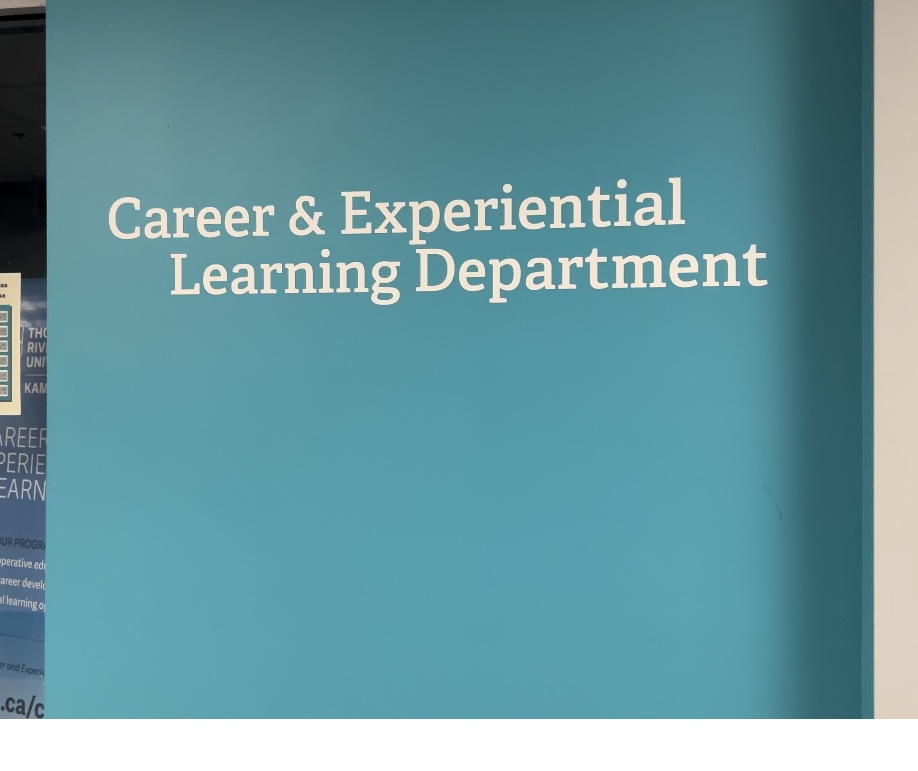
With an increasingly competitive job market, Thompson Rivers University (TRU) has built a co-op program that provides students with relevant work experience. This program not only equips students with a good resume and cover letter, but it also enhances their ability to thrive in the workforce. Larry Ilesan, Associate Teaching Professor and faculty leader of TRU’s Career and Experimental learning department commented “TRU has crafted a co-op program that offers a practical exposure while empowering students to take control of their career paths.” To gain a fuller perspective on the programs benefits, I spoke with Larry and Quwamdeen Ajibola Iribigbe, a recent co-op student who gained hands on experience in Alberta’s logistics industry.
According to Larry, the co-op program at TRU addresses a critical need for students to acquire external work experience in line with their current program on study and their career goals. “The worst thing a student can do is graduate without any real experience outside the university”, he emphasises, that the co-op bridges a gap between theoretical learning and practical application. With the co-op experience, students can get a feel the real-world environment, learning to apply their academic knowledge in settings that demand adaptability, problem solving and professionalism. However, Larry noted that the co-op program doesn’t directly “place” students in roles. Instead, TRU has developed an innovative approach to help students find positions themselves, fostering independence and proactive decision making. Through career connections, TRU’s exclusive job-matching platform, organizations across Canada post positions that align with the co-op curriculum, allowing students to choose opportunities that fit their aspirations. “Co-op empowers students to take control of their careers and actively engage with the job market,” says Larry, adding that this aspect is essential for students in post-graduation challenges.
Recent TRU co-op student Quwamdeen Ajibola Ibiribigbe provides a fascinating perspective on how these experiences can influence a student’s future career. Quwamdeen was fully involved in the fast-paced world of logistics during his co-op time with Trimac Transportation in Alberta. To support dispatch operations, he had to track deliveries, organize shipments and keep lines of communications open with clients and drivers. As he considers his everyday duties, Quwamdeen emphasizes the value of clear communication and attention to detail. He says, “In order to prevent delays and inform clients of shipment statuses, I had to keep a close eye on routes” “From adjusting to unforeseen traffic conditions to making sure that all shipments were executed smoothly, everyday presented new challenges”. The experience strengthened his confidence and expanded professional skill set, giving him a competitive edge he might not have developed otherwise. Quwamdeen’s story underscores the transformative nature of the co-op experience, where theory meets practice and students gain insights that align with their career paths.
TRU’s co-op program goes beyond job placements – it is a well-coordinated system of partnerships across diverse industries. Larry explains that the university maintains steady relationships with a broad network of companies through regular outreach efforts, faculty participation at industry events, and direct communication with employers. These partnerships ensure a continuous influx of co-op opportunities for students in various fields, from technology and healthcare to logistics and finance. “it’s essential to build credibility with employers, and TRU’s accreditation in co-operative education assures them of the programs quality,” he adds. This longstanding tradition of work-integrated learning positions TRU’s co-op program as a vital resource for students seeking to break into competitive fields. This program has been operational since 1992. The department has three elements to it and not just the CO-OP program, this includes career services and experimental learning – It is open to all students that have the option in their program of study. Students are not chosen, they apply and based on availability and other factors are admitted into the Co-op program.
The variety of industry partners also highlights the adaptability of TRU’s co-op program. Larry points out that co-op isn’t limited to a specific sector; rather it severs as an entry point or hub into multiple industries, allowing students to explore into multiple industries, allowing students to explore and refine their interests. From companies that require tech-savvy problem solvers to those needing hands-on management skills, TRU’s program aligns students with organisations that match their goals, ultimately broadening their careers horizons.
For many students, enrolling in co-op can be seen as daunting, as it often requires stepping out of your comfort zone. Larry notes that one of the most common challenges for TRU students is the need to relocate outside Kamloops for placements or to build confidence to apply for highly competitive positions. However, TRUs faculty members are committed to helping students overcome these obstacles, providing personalize support through one-on-one sessions. “We work closely with each student to help them overcome location-related concerns, enhance their skills and build the confidence the need to pursue ambitious goals,” Larry says. Quwamdeens journey reflects this faculty support, as his coordinator provided guidance and encouragement, helping him tackle the demands of his Alberta placements. This guidance was instrumental in helping him take on the responsibility of a demanding logistics role, and he credits his coordinators support for helping him overcome the initial apprehension of working far from home.
TRU’s co-op program is designed not only to place students in jobs but to fully equip them for professional success. Before beginning their placements, each co-op student must complete a 13-week career management course which is worth 1 credit. This course prepares students with resume building strategies, job search techniques and interview skills. Larry explains that this preparation is essential, as it ensures that students enter the job market with confidence and are ready to meet employer expectations. Once on the job, co-op students will continue to receive support through regular check-ins with faculty coordinators and even a site visit is possible. This helps students to reflect on their experience, navigate workplace challenges, and refine their skills. These touch points ensure that the transition from classroom learning to workplace application is smooth and constructive.” Our role is to help students not just secure positions but to also thrive in them,” Larry explains, emphasizing that co-op is as much about learning and growth as it is about gaining experience.
As Larry suggests, “Students need to graduate with experience that makes them stand out in today’s labor market.” Co-op gives many people the chance to explore a variety of disciplines, validate their career routes, and establish a professional network at an early stage. Larry highlights that students who wish to prosper after graduation must now have relevant work experience; it is no longer a choice. He emphasizes the value of work-integrated learning by saying, “Students across the country are doing this, and they need to be competitive.”
Quwamdeen also gives guidance to people who are thinking about co-ops but aren’t sure. He explains how his work in logistics helped him see how his education applied in the real world and opened his eyes to new career options. He urges students who might be hesitant to embrace co-op to take is as a journey of self-discovery. “You learn so much about yourself, about what you’re capable of, and about where you want to go,” he reflects.
The co-op program at TRU has grown to be a crucial component of the university’s curriculum, preparing students for a workforce that prioritizes preparation, flexibility, and real-world experience. The curriculum serves as a link between classroom education and career success rather than just a stepping stone. According to Larry and Quwamdeen’s experiences, co-op at TRU is more than simply a choice for students; it’s a life-changing experience that gives them the abilities, perspectives, and self-assurance they need to succeed in their chosen industries.
As the need for work-integrated learning increases, TRU’s co-op program keeps developing, giving students a competitive advantage and a worthwhile chance to obtain practical experience. The success of the co-op program demonstrates the university’s dedication to students’ development, fortitude, and preparedness for the workforce, opening doors for graduates.

Quwamdeen Ajibola Ibiribigbe- current TRU student.
B.C. Government’s Involuntary Care Announcement Meets Mixed Reviews
Written by Diego Machado
Health professionals and mental health and addiction counselling organizations are questioning the B.C. provincial government’s announcement that involuntary care services in B.C. would be expanded. The BC Division of the Canadian Mental Health Association released a newsletter in response to the announcement, urging the provincial government to be cautious with expanding an already struggling involuntary care program over voluntary mental health services to address the addiction crisis in B.C.
Public sentiment on B.C. Premier David Eby’s September 15, 2024 announcement that the province would expand involuntary care services in B.C. by renovating and updating two secure care facilities—one for patients from the criminal justice system and one for those apprehended under the Mental Health Act—and adding 400 new hospital-based beds.
Many parents who lost their children to battles with addiction or mental health issues are advocating for the effectiveness of these services. However, members of the public and healthcare professionals are concerned about the expansion, because the effectiveness and current operating state of involuntary care are questionable at best.
At the September press conference, Premier David Eby said, “People with addiction challenges, brain injuries and mental health issues need compassionate care and direct and assertive intervention to help them stabilize and rebuild a meaningful life.” He elaborated on the context of expanding the current involuntary care service as the next step in the provincial government’s response to the ongoing addiction crisis.
According to the Office of the Premier, the first correctional center will be at the Surrey Pretrial Services Centre, and the first secure housing and care facility will be on the grounds of the Alouette Correctional Centre in Maple Ridge. At the time of writing, the provincial government hasn’t clarified an expected timeline for the renovations.

photo courtesy of The Globe and Mail. https://www.theglobeandmail.com/canada/article-bc-to-introduce-involuntary-care-for-people-with-addictions-premier/l News.
The government’s official digital press release on its website echoes support for this expansion of involuntary care services from Grace George, Jen Thomas, and Wayne Sparrow, the chiefs of the Katzie and Tsleil-Waututh Nations and the Musqueam Indian Band, respectively. Ken Sim and Dan Ruimy, the Mayors of Vancouver and Maple Ridge also voiced support for the expansion announcement.
“This is an incredibly profound first step in addressing the mental health and addiction crises that Vancouverites and British Columbians have been grappling with,” said Ken Sim, in the release. “As we embark on this new chapter with mandatory care, we are extending a lifeline to those who need it most. We thank Premier Eby and all those involved for their work to make our communities safer for everyone.”
However, the British Columbia division of the Canadian Mental Health Association (CMHA) released a newsletter three days later questioning the validity and credibility of expanding involuntary care services.
Alfred Achoba, executive director of the Kamloops branch of the CHMA, says that involuntary care services are crucial and beneficial, and believes this expansion will have an impact on places like Kamloops that are struggling with the addiction crisis. However, he also shares the concerns of the CMHA B.C. newsletter.
“I have concerns, like many other professionals around the expansion and reasons behind (the announcement),” he said.
He says his reasoning has to do with two things: whether or not they are giving care with compassion, and whether the data on involuntary care shows that it fulfills the purpose it exists to serve. He doesn’t believe either of these are up to standard.
“(In) hindsight, I think there’s so much work that should have been done before that news was released. And I think the province is probably now trying to respond to some of the concerns that have been raised.”
He also expressed that the cost of this expansion, which the province has not stated, could be better used to increase the operational capacity of voluntary care services in places like Kamloops.
Achoba and the B.C. CMHA believe that voluntary services should be better funded and maintained as a form of preventative care. This would alleviate the pressure of a rising addicted population in B.C. on the involuntary care system, allow for more thorough and compassionate care for those struggling with addiction, and hopefully restore trust in the system itself.
“A key part of the public concern is looking at the level of support we have now for voluntary care, the lack of support, the lack of funding,” he said. “Kamloops alone, we only have 10 detox beds. So when people are struggling with their mental health, you’re just going to lock them up knowing fully well the government hasn’t met their needs when it comes to funding those programs.”
“I think it is a bit alarming, and we need to do more of a reflection on the existing services and supports we have. Do we have enough? The answer is no.”
According to the B.C. CMHA, B.C. already has the highest apprehension rate for individuals under the Mental Health Act out of all provinces in Canada, at 30,000 apprehensions of around 20,000 individuals.
According to a peer-reviewed medical analysis of B.C.’s involuntary care system in the Canadian Journal of Psychiatry from 2022, the largest group of these apprehensions are people with substance use disorder. This is the fastest-growing population being detained under B.C.’s Mental Health Act.
The B.C. CMHA also emphasizes this analysis’ criticisms of the accessibility of existing voluntary mental health and addiction services, maintaining that the province is leaning on involuntary care to deal with the mental health and addiction crises, and neglecting their responsibility to voluntary care services as a form of prevention.

photo courtesy of Q101
The Newsletter states, “Over the last two decades, there has been a dramatic increase in reliance on involuntary services, while voluntary services have not kept up with demand… Without addressing root causes and interrogating the gaps and failings of the current system, even with involuntary care, people will be released back into community without the necessary supports needed to help them on their journey to wellness. The cycle will continue.”
In addition, the newsletter expresses concern over the current levels of oversight and accountability for the mental health system in B.C., and that this expansion of the involuntary care system, “will not lead to positive or dignified outcomes for people.”
Darren Gulka, a psychiatric nurse with almost 30 years of experience working in mental health and substance abuse, said that the method of care for patients struggling with severe addiction and mental health issues is at the discretion of the doctor overseeing their care, and would involve isolation chambers or torso restraints.
“It needs to be ordered by a physician to make it happen. It’s not like regular staff in inpatient psychiatry could decide to put someone in a seclusion room or put restraints on them,” he said. “They would have to get a doctor’s order, and usually, they’re concerned that somebody might harm themselves or harm somebody else.”
Gulka also thinks that there are methods that are proven to be more effective when dealing with an addiction than involuntary care such as Portugal’s model, which legalized all drug use and treated addiction the same way the medical system would treat a disease.
“The Portugal model was phenomenal and did well, and is not doing well now. It’s because they made a bunch of cutbacks after everything was doing well. What they showed is that after decriminalizing personal use of substances, they also put in all the resources to allow people to have access to housing, training for work, funding, whatever they could throw at them resource-wise to help them. And it just, it did phenomenal.”
Referencing the CMHA newsletter and the cited journal article, Gulka said he believes that the public and entities like the CMHA, who are partnered with the provincial government and Interior Health and work closely with them, should be more involved in the process of decisions like the involuntary care expansion. “We worked very closely with the CMHA, they have a contract with Interior Health. I would support CMHA B.C..” said Gulka.
For more information on the B.C. Government’s involuntary care announcement, view the full digital press release here:
https://news.gov.bc.ca/releases/2024PREM0043-001532
To read the B.C. CMHA Newsletter, click here:
https://bc.cmha.ca/news/involuntary-care-in-bc/
Art for All: Misfits Wanted
The chilly Friday night was alive with energy as attendees from all over Kamloops gathered at the Sandman Hotel to visit the Misfit Night Market on October 18th, 2024. This local market drew in a crowd of close to 700 people, all eager to participate in the community that has been created. Emphasizing its connections to various under-represented groups in Kamloops like the LGBTQ+, punk, or alternative communities, the market is truly inclusive. With a shared love for creativity, and community, the Night Market is more than an artisan bazaar- it’s a sanctuary for unapologetic self-expression.

The Misfit Night Market showcases, “the people who didn’t necessarily fit in, and the vendors who don’t fit into your standard craft market,” describes Jess Santos, creator of the Misfit Night Market and owner of Haus of Misfit when asked about the demographic of the market. “I’m trying to give space to those people who are more alternative, witchy, queer, nerdy…the freaks and geeks.” As a local in Kamloops, they recognised a lack of spaces that were truly inclusive for all communities to gather. Each niche had their own small events but unless you ran in those circles you would never know about them. By creating the Misfit Night Market, they hoped to bring these smaller, underrepresented communities together and allow people to express themselves more fully. Having spaces that are inclusive and more importantly, safe, for members of marginalized groups is a rare occurrence in town and the Night Market is an oasis in this desert.
Conceptualised in late 2019, the first Misfit Night Market was set for March 28, 2020. Which in hindsight, turned out to be a difficult time to organise large events. However, the love and passion shown from the community for even the idea of a market like this was enough, fire had caught and it wasn’t going to be extinguished. Forging ahead, Jess moved the first Night Market to October 30, 2020 and – with some modifications- made a covid-friendly market. Selling various goods from art prints, to handmade soap, to jewellery, and clothing, the market offered something for everyone. Reflecting back on it she said, “It was a tiny thing. I didn’t have any vendors, I just had their tables set up and it was just all the artisans stuff. Then I was there selling it all for them, and then paying them the money after.” Word of this unique market spread quickly and vendors and customers alike were clamouring for more.

Both artisans and attendees feel a special connection with the Misfit Night Market. “It’s just overall been the best experience for me,” said Avery, the owner of AvesCreations and long-time vendor with the market. “I’ve been the most profitable, had the most fun, and met the most people. So I’ve stuck with that market. It’s the one where I know I need to sign up cause I would rather do that one than any other market.” They had a large table sprawling with jewellery like rings, necklaces, and boot chains which catered to the alternative crowd at the market. Selling their custom jewellery at these markets, they enjoy being able to form more connections within the community. And with the diverse crowd the market draws, they appreciate that, “It’s an inclusive place, where all of us can come together.” Despite every vendor selling different works, a respect and mutual understanding exists between them that this event is a privilege to be a part of, and their enthusiasm in partaking is infectious.
Tucked away in one of the corners of the stuffy room was artist Dre Levant, selling his original framed artwork. Despite the mass of people trying to navigate through the narrow path between booths, he looked at home behind his table. Chatting with passer-bys, and engaging with those interested in his work he was able to balance all the roles required of him expertly. As his fourth Misfit Night Market, Levant is no stranger to the vendor lifestyle. A self proclaimed “misfit” he has tried other local markets like the Farmers Market, but found that he didn’t quite fit into the expected mould of an art vendor. “My art is a bit more on that alternative side. It’s a little bit creepy, a little bit cute,” he said when asked about why he prefers the Misfit Night Market over other local markets. “For me being on the misfit side of things, being a queer person- a queer creator, and someone who likes to make art that’s kind of weird, or strange, or even grotesque to some people, I think going to the Misfit Night Markets is ways to find people who align with that as well. And who are on the same wavelength as you. Other queer people or people who feel just a little bit different.” As a Visual Art student at Thompson Rivers University, Levant is exploring his identity through his art. Even when creating pieces that are self described as strange or horrific, he finds that other students often don’t understand his pieces. But at the Misfit Night Markets, he feels understood. Speaking about the market he said, “It’s just a space where you can be weird here, you can be different here, you can be as visibly queer as you want to but everyone here’s just going to accept you, and I think that’s so important to have spaces like that.”
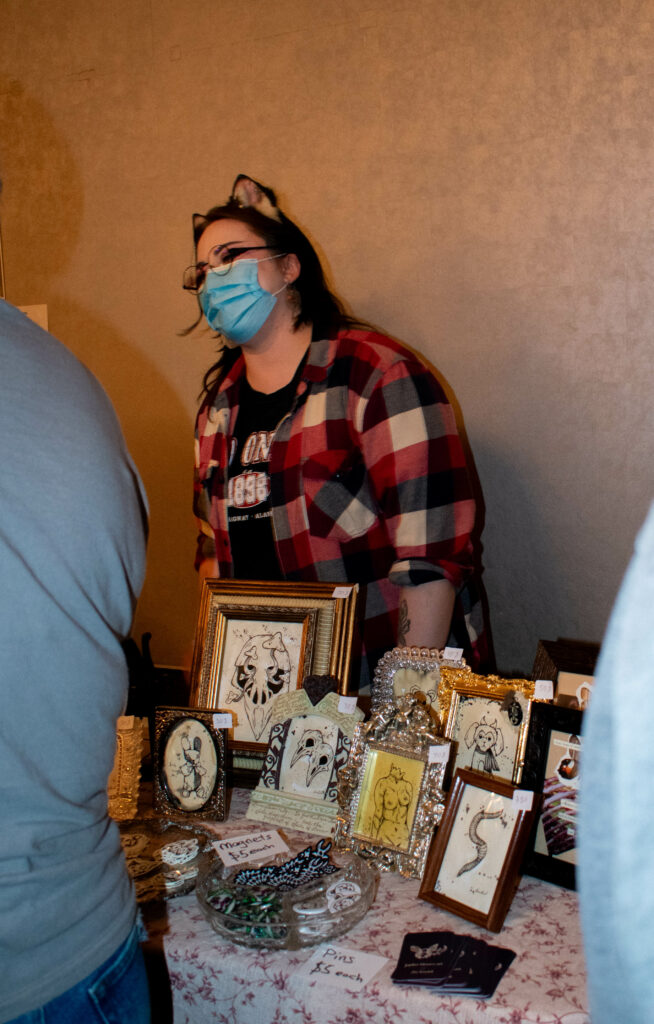
An anonymous attendant at the market commented on the importance of spaces where people can feel safe, “Kamloops really needs more events like this, where kids- not just kids but it’s important for them- to see different ideas and possibly recognize themselves in the community that’s around them.” As an all ages event, the Misfit Night Market is, “for everyone, except for jerks,” Santos said on the idea of making the event child-friendly. “I want the kids who feel more alternative, give them a place that they feel like they feel represented in Kamloops.” According to Elections BC data from the 2024 Provincial election, Kamloops had a Conservative vote of 49%, with the closest party being NDP with 41%. As a city that houses Conservative views, queer people and other minorities feel more unsafe and unsure than ever. Being able to gather at events in person and see that they are not alone is pivotal for the longevity of these communities. The Misfit Night Market provides not only an option for communication amoung each other, but a chance to form strong community bonds that are vital to survival.
Despite the overwhelming success of the market in terms of sales and attendance, it is a rare occurrence. With only four markets in 2023, and two in 2024 the time between events fluctuates. “Usually by January I have the dates and locations in mind and because Kamloops does not have a ton of venues, it’s good to always get that taken care of right away,” Santos explained about her behind the scenes preparations. She then described how she sends out the call for vendors through Instagram and Facebook, receiving anywhere from 35 to 70 applications. Applicants are then placed on a waitlist where Santos picks the vendors depending on location size, trying to accept as many as possible. Only once accepted do vendors pay a table fee around $70, and Levant is happy to pay this. Making several hundred dollars throughout the night offsets the initial table fee. Santos then does a daily creator feature on the Misfit Night Market instagram page running up until the week before the market. With so much experience under their belt now they feel it is, “A little formulaic, and there are a lot of hidden things that go into it, but there’s always small hiccups.” However, this doesn’t dissuade her from continuing to organise the market.
In a city that often lacks safe spaces for queer and alternative communities, the Misfit Night Market stands out as a vibrant reminder of the power of art to bring people together. By supporting and uplifting these communities, Santos and many others through the Market are providing respite through the tumultuous storm that is the future of Kamloops. Connections are the most important thing that a community can have at times of unrest or instability, and by allowing a physical space for people to share themselves with others, these communities are growing and being bolstered by their own strength. Supporting each other by vending at the market, visiting the physical Haus of Misfit, or buying directly from artists through their social media, people in the Kamloops community can all participate in this niche community. Staying informed of future events by following the Instagrams: Jess Santos @misfitnightmarket, Dre Levant @jupiter.bloom_art, and Avery @avescreations, allows further inclusion into this marvelous market.
UMO Transit App Fails to Reach All Students: Lack of Awareness About Physical Cards Creates Confusion
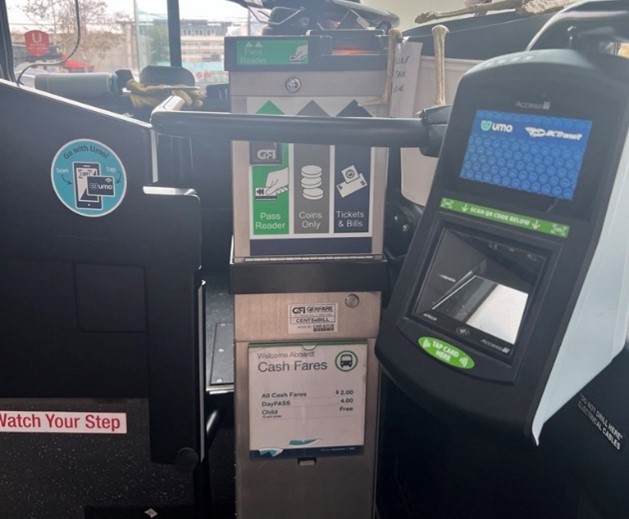
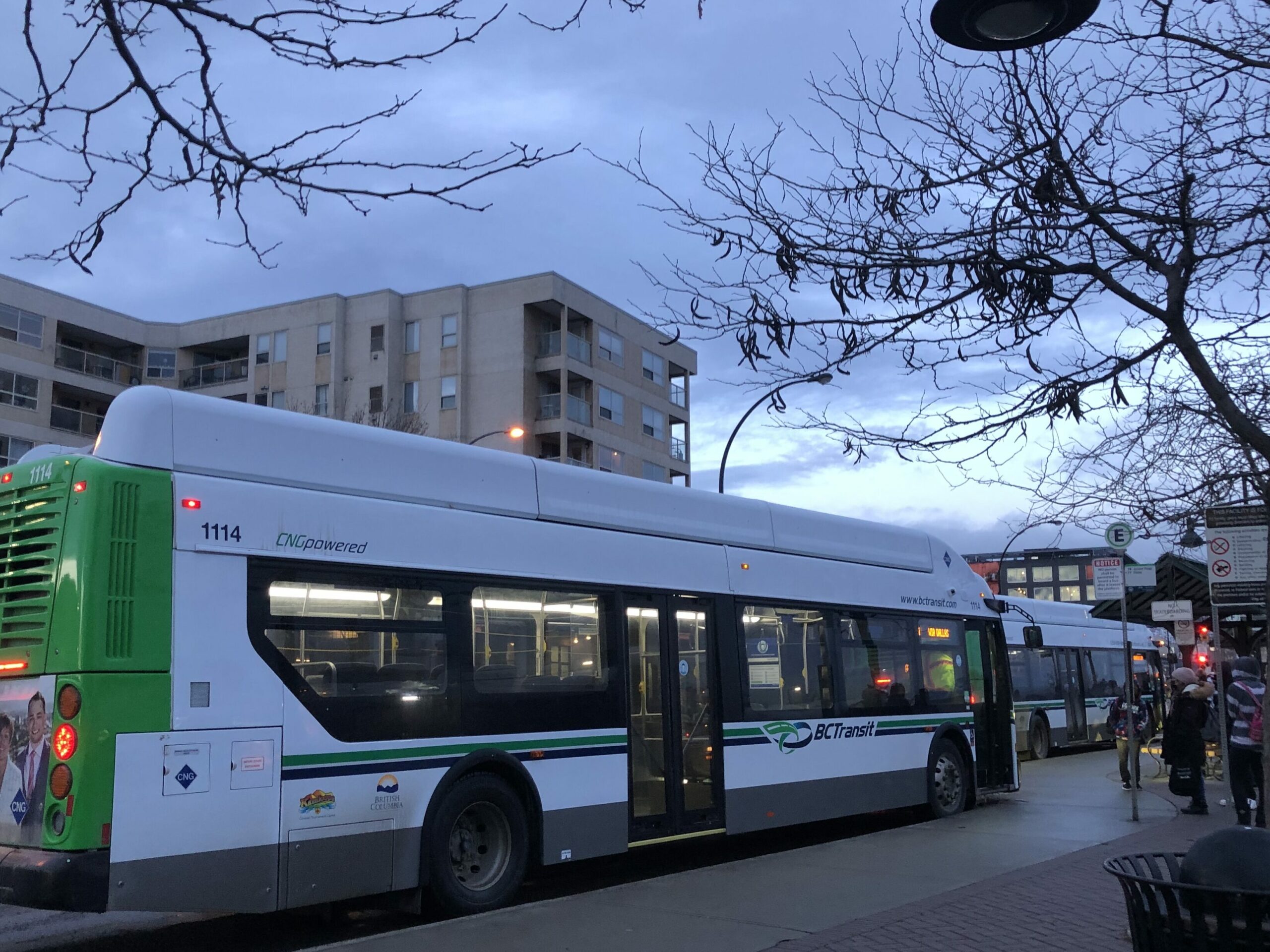
Since the February 2024 launch of the UMO transit app, Thompson Rivers University (TRU) students and locals have experienced app bugs that have left them stuck at bus stops. Most students are not aware that UMO provides a physical card as a backup or second option, because there is little information shared about where to get one. As the demand for public transportation increases with the start of the school year, this ignorance has left riders confused. Although physical cards are free and accessible in limited places, they provide a reliable substitute for app problems, however, more work needs to be done to inform students about this choice.
While physical cards are still an option, they are not distributed by the university, confirms the Student Union (SU) at TRU. Students seeking a physical card must obtain one from a UMO or BC Transit vendor. This change has caused some confusion among students who were accustomed to receiving cards directly from the Student Union. Physical cards are still preferred by many students because of their reliability. In the past, students would directly pick up their bus passes from the Student Union. Students would activate their bus passes at the SU desk, but they would only pick up the card once as it was also their student ID. The student ID now serves little purpose to students aside from a secondary piece of ID. Instead of a physical card, students now receive a code via email since the UMO system was implemented. Many people continue to visit the Student Union despite this shift in order to ask questions about getting a physical card or to get help using their digital codes efficiently.
A first-year student who regularly uses public transit, Amanpreet, talked about her experience. She claimed she was unaware that she could obtain a physical card until a friend informed her, “I am happy that there is an alternative because the app has crashed on me multiple times, but it would have been beneficial if we had been informed about it earlier with the email when student union give us our app code.” The flexibility of the UMO system, offering both digital and physical pass options is designed to meet different needs. However, a better awareness and clearer communication could help more students, like Amanpreet to take full advantage of these features.
Simranjit, service coordinator at Student union confirmed that UMO’s customer service handles most technical inquiries, though TRUSU also provides guidance when needed. He added that digital pass allows students to purchase and manage bus passes through the UMO mobile app, which also grants access to facilities like the Tournament Capital Centre (TCC).
The university is aware of the need for clear communication about the new system. They have created a dedicated U-Pass page on their website with FAQs and contact information for customer service. Students experiencing issues are encouraged to contact UMO customer service first, with university staff available for additional support. As the Kamloops transit system continues to evolve, both BC Transit and TRU are committed to addressing student concerns and improving the user experience of the digital bus pass system.
“We wanted to make our bus system more digitized and easier for everyone to use,” a Kamloops Transit Office worker clarified. The Officer added, “For this reason, we released the mobile application. However, we still provide physical cards because we understand that not everyone prefers to use their phone for everything. Many people inquire about them, which is perfectly fine. They continued by saying, “We have posted all the information on our website, but we are starting to realize that it might not be as clear as we initially believed. We continue to receive inquiries from people concerning the actual cards. We will come up with more effective ways to spread the word”.
Even though the UMO system transition has been challenging, it is apparent that many of the present inconveniences could be resolved with improved communication about all of the options. The Kamloops Transit Officer encourages all users who are having trouble with the app to try the physical card option while they continue to improve the system. By providing both digital and physical options, Kamloops Transit aims to accommodate the diverse needs of its riders, ensuring that everyone has access to reliable public transportation. “We are committed to providing a reliable and accessible transit system for all Kamloops residents,” said a Transit Office worker. “We appreciate our rider’s patience as we work through these initial challenges.”
“Look, we are just a couple of months into this new system. There are going to be a few bumps in the road. We learn as we go, and we really do appreciate everyone’s patience,” he said. “Once people get used to it, I am sure things will go much smoother. Change takes time, we are all in this together, and we are committed to seeing it work for everyone.”
As Kamloops adjusts to this new transit system, one thing becomes very clear: if the app isn’t working out for anyone, then there is always the option for a physical card. Riders can choose any option that ensures seamless access to transit. Although mobile access was designed to be convenient and accessible, there are still few problems that need to be fixed for it to work for all users.
Free physical UMO cards are available at a number of handy locations around Kamloops. These places consist of:
- ABERDEEN MALL 275-1320 West, Trans-Canada Highway
- CANCO 204 Tranquille Road
- CHEVRON 2711 Westsyde Road
- LONDON DRUGS 216- 450 Lansdowne Street
Riders can pick up their physical UMO cards at any of these locations. For people who would rather not rely on a mobile app, this option is especially helpful because it protects them from possible app malfunctions and guarantees that they can still use their transit pass even if their phone battery runs out. They can add their digital pass to the physical card by either visiting these places or doing a direct transfer within the app settings. Simply log into your account settings in the UMO app and click “Transfer to Physical Card.” This feature makes it easy to let riders switch seamlessly between digital and physical options. This allows riders to enjoy the convenience of a mobile app while having the security of a physical backup
“Once I figured out how to use the physical card, it became much more reliable,” says Amanpreet, who recently made the switch. “I just wish I did know about it sooner.”
TRU Begins Construction on Innovative Low-Carbon Energy System
Thompson Rivers University (TRU) is taking a significant step toward a greener future by constructing its Low-Carbon District Energy System (LCDES). The centerpiece of the LCDES project is the construction of the Sustainability Powerhouse.

As James Gordon, manager of sustainability programs at the sustainability office at TRU, says, “Half of the building will serve as an energy plant equipped with cutting-edge electrically powered air-source and water-source heat pumps alongside backup electric boilers. Then, if the electric boilers can’t keep up with the energy consumption, the natural gas boilers will make up the difference.” The Powerhouse will generate heat and distribute it through underground pipes to 13 existing campus buildings, including Arts and Education, BC Centre for Open Learning, Campus Activity Centre, Clock Tower, Culinary Arts Training Centre, Brown Family House of Learning, Indigenous Education Centre, International Building, Ken Lepin Science and Health Sciences Building, North Tower Residence, Old Library Administration and Research Annex (OLARA), Old Main and TRU Gymnasium. “Another cool thing is that the system can heat all the new condominium buildings and the Canada games pool in the tournament centre as part of The Reach development on campus.”
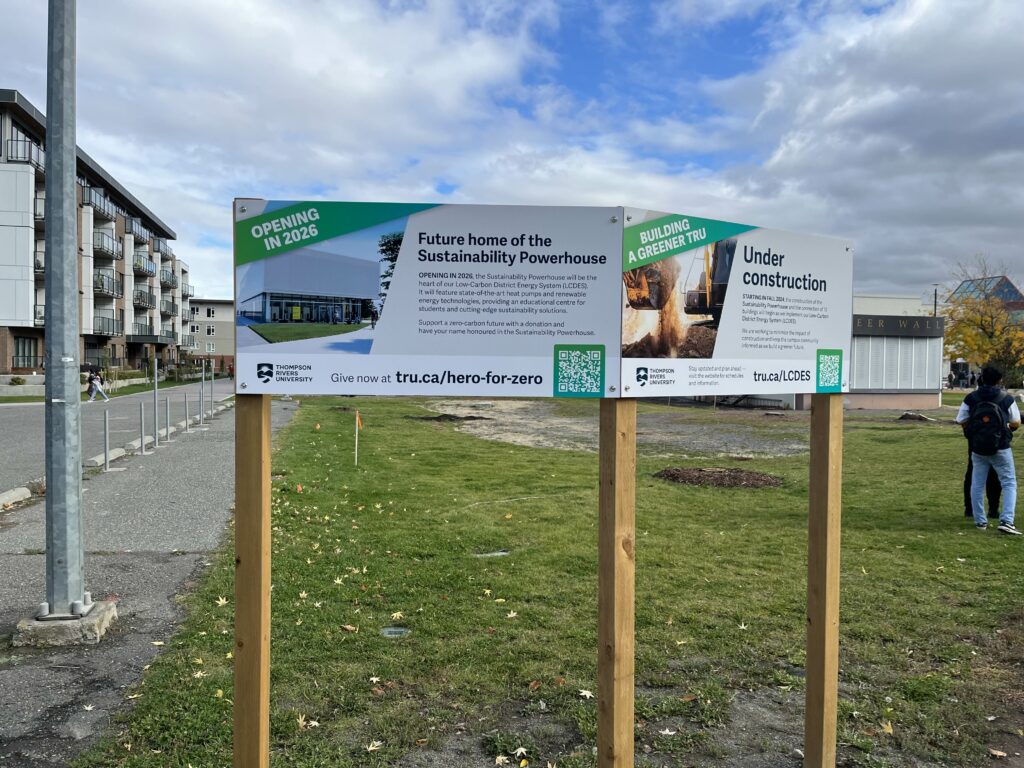
The other half of the Powerhouse will house the TRU Sustainability Office, a hub of environmental innovation and leadership. The office will use the Powerhouse as a “living lab,” showcasing state-of-the-art sustainable energy systems. Gordan mentioned, “The underground closed-loop distribution system will connect buildings across the campus, allowing TRU to phase out its aging boiler systems and transition to more efficient, renewable heating.”
The journey toward the LCDES began in 2021 when TRU engaged in public consultations to gather feedback on the project. By 2023, after refining its proposals based on public feedback, TRU submitted the project for review by the BC Utilities Commission (BCUC). The commission’s approval of the first phase of the system marked a significant milestone, providing the green light to move forward with the construction of the LCDES. This phase focuses on connecting key campus buildings to the new energy system, integrating innovative heating and cooling technologies that rely on renewable energy sources.
In addition to securing regulatory approval, TRU conducted another round of public consultations in 2023, this time focusing on the proposed second phase of the project. This phase envisions expanding the energy system to include more buildings, further enhancing the university’s ability to cut carbon emissions. The public consultations allowed TRU to present details on the expansion and gather feedback from the community, which continues to play a vital role in ensuring the project’s success.
When finished, the LCDES will not only meet TRU’s immediate energy needs but will also establish a scalable framework for future expansions. When asked about the impact of this project, Gordan said, “This project aims to drastically reduce the university’s greenhouse gas emissions by 95% by 2030. But of course, there is that 5% that is contributed to by people driving their cars to campus and other factors that TRU can’t exactly control. So, we are doing our best to ensure that the fossil fuel emissions we can control are as minimal as possible.” This approach underscores TRU’s long-term commitment to sustainability and ensures that the university will remain at the forefront of environmental innovation in British Columbia.
The Low Carbon and Energy-Efficient System (LCDES) is a step toward lowering carbon emissions and a comprehensive solution engineered to prioritize both resilience and sustainability. By integrating advanced air- and water-source heat pumps, the system ensures that renewable energy is the primary source for heating across the campus. These heat pumps efficiently extract thermal energy from the surrounding air or water, even at low temperatures, to meet the heating demands, significantly reducing reliance on fossil fuels.
In keeping with resilience planning, the system also includes electric and natural gas boilers that serve as a backup, ensuring uninterrupted heating during periods of peak demand or in extreme weather conditions when renewable sources might not suffice. This dual setup balances sustainability with reliability, making sure that while renewable sources are the focus, there is always a safeguard in place to maintain the campus’s heating needs.
Additionally, using heat pumps lowers greenhouse gas emissions by tapping into renewable energy sources, reducing the carbon footprint, and promoting long-term environmental sustainability. This design also supports the broader energy efficiency goals, contributing to reduced operational costs and aligning with the campus’s overall commitment to sustainability.
Strong partnerships with Creative Energy and BC Hydro have driven the development of the LCDES and have been instrumental in advancing this clean energy initiative. Together, these partnerships are helping TRU create a more sustainable campus while positioning the university as a leader in renewable energy solutions.
Sources:
Thompson Rivers University. (n.d.). Low carbon district energy system (LCDES). Thompson Rivers University. https://www.tru.ca/sustainability/lcdes.html
Thompson Rivers University. (2024, August 29). TRU breaks ground on landmark low carbon district energy system. Thompson Rivers University. https://inside.tru.ca/2024/08/29/tru-breaks-ground-on-landmark-low-carbon-district-energy-system/
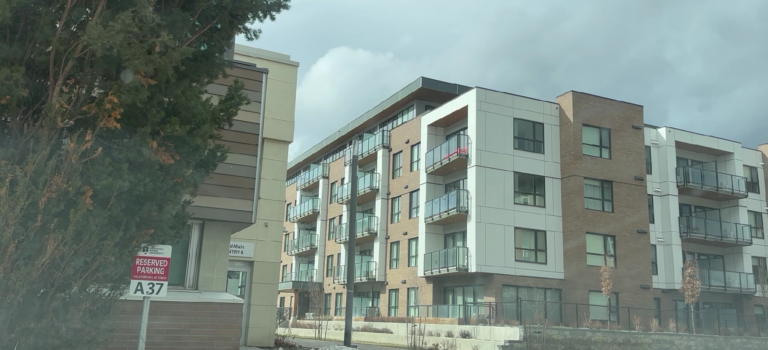
As Kamloops housing crisis continues, international, new, and returning TRU students are left searching for affordable units
TRU students face many problems during the summer months as they fight to secure housing for the upcoming school year. First-year and new international students require housing but, unfortunately, finding it isn’t as easy as it once was. Drastic measures have been taken by the school in order to house students.
“Camp like” structures called modular dormitories were implemented in early 2021 to attempt to combat this major issue. Kristen Holliday, a local journalist states “Thompson Rivers University is moving forward with plans for temporary modular units on campus to be used for student housing, but building permits for the project have yet to be issued, according to the city.” These decisions have raised questions about the safety and living conditions of students on campus. Measures like this are the unfortunate truth for TRU students as we deal with limited housing, increased inflation, and the rise of rent.

(Apartments for rent on TRU campus, Photo by Michael Friesen)
“Although inflation has dropped from the past year’s historic highs, the cost of living across B.C. continues to increase rapidly,” senior economist and lead report author Iglika Ivanova said in a press release. Though prices have dropped in recent years in terms of things like gas, housing can be a different story. Rental rates in Kamloops haven’t followed this trend.
Because the cost of living is higher, this affects things like grocery stores, restaurants, and retail stores. Students at TRU are expressing their concerns when it comes to this topic. Conor Vanden-Huevel, a fourth-year Business student has been battling the issue of housing in Kamloops since his first year. Conor expressed his frustrations with the current situation by saying “In my first year I couldn’t get into residence due to limited space, this made me search for other places to live in Kamloops. I’ve looked at lots of potential places though the large majority are either too expensive for my budget, too far away from campus, or too small for my needs.” This shows the harsh reality that students are facing when they plan to attend TRU.
Conor goes on and states “In my second year, I was living in a studio apartment in a complex near campus. I kept the place from my second year going into my third. The landlords increased the rent from $1,100 to $1,300 just over the course of a year.” It’s impossible to tell when price increases will stop or slow for residents of Kamloops. Price increases as a result of inflation mean that new residents are less likely to call Kamloops home. This will create things like understaffed businesses and less income overall for the city of Kamloops. Pressing issues in Kamloops like parking, homelessness, and forest fires may not get addressed with the funds and backing that they would if the population was steady.
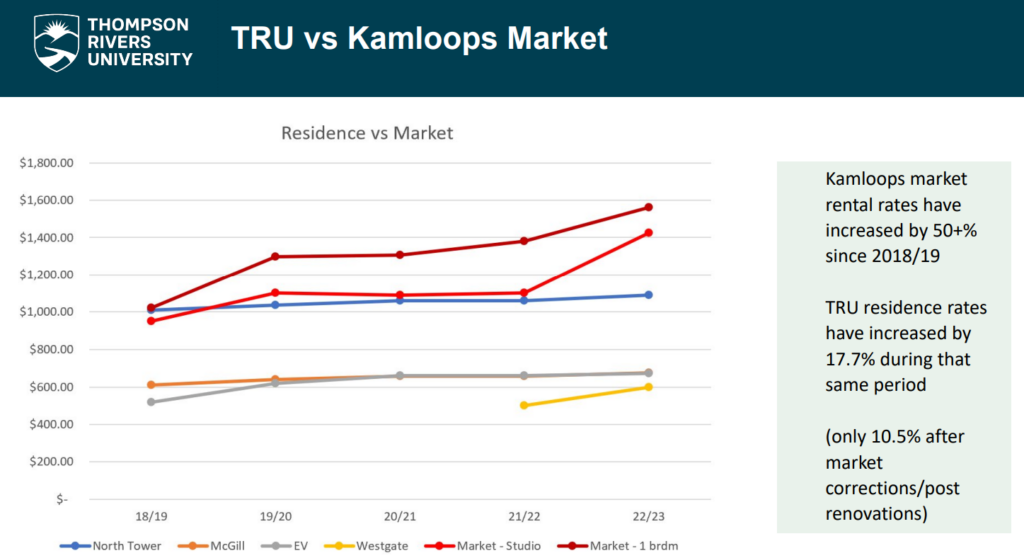
This graph displays inflation rates and the differences between TRU housing vs the Kamloops market. It’s important to note the staggering 50% inflation increase since 2018 and 2019. This puts the major inflation problem into perspective. While TRU housing has also been affected by inflation, it has not been nearly as bad as the Kamloops market. Since 2018, the TRU residency rates have increased 17.7%, and while still large, they are nowhere near the rates of the Kamloops market. The problem with TRU housing is the limited occupancy, meaning affordable housing isn’t available to every student.
(TRU vs Kamloops Market Housing Graph From: https://www.tru.ca/__shared/assets/Student_Housing_Update_presentation56092.pdf)

While Canadians and students are facing these problems, there is some hope. Inflation rates have been slowly regressing and new regulations are being put in place by the municipal government to combat the housing crisis. Only time will tell what this means for TRU students.
With the upcoming 2024 provincial election, there is some hope for students. Housing is at the forefront of issues currently in B.C., and this issue cannot be ignored by the candidates. Plans for affordable housing are included in all of their campaigns. As the election gets underway there is hope for new regulations and initiatives to be put in place by the new premiere. Coming to Kamloops to work or attend TRU now poses a major financial problem. This problem becomes even worse for international students as they are forced to pay higher tuition. While the rates of inflation seem to be on a more sustainable trajectory, housing for TRU students and residents of Kamloops seems to only be coming more of an issue.
(BMO located in the Summit Village Market. Photo by Michael Friesen)
The Widespread impact of Addiction on the Kamloops Community
Nempurrkel Sikar

Kamloops has always been known for its jaw dropping mountains and scenic hiking trails but recently, the rise in opioid addiction is reshaping the city’s identity. The issue at hand is crippling the community, affecting families, businesses, neighborhoods and putting the entire city on edge.
The story behind the rapid growth of addiction in Kamloops starts on the 31st of January 2023, when Health Canada granted the province of British Colombia a three-year exemption, under the controlled Drugs and Substances Act. The aim of this was to decriminalize the possession of small amounts of illegal substance for personal use for people over the age of 18. These illegal substances include A class and B class drugs, such as cocaine, heroin, ecstasy and ketamine.
Local support and addiction workers are overworked and understaffed as they struggle to keep up with the demand for assistance in addiction facilities. A statement on the Interior Health Overdose Prevention site has expressed the spike in the number of people seeking help from overdose prevention facilities. Unfortunately, these programs have waiting lists that can be months long.
“Working at Sage Health Centre has been extremely exhausting; my shifts start in the morning and ends late at night. I am constantly surrounded by addicts, some who are trying to better themselves and some who never will” said Charlotte Kemigisa, a frontline worker at Sage Health Centre.
According to CMHA Ontario it is said that “Approximately 21% of the population (Approximately 6 million people) have met the criteria for addiction in their lifetime.” Also, according to CMHA “Kamloops has one of the highest rates if youth overdose deaths in British Colombia in accordance with the opioid crisis in 2023.

“Seeing the various amount of people come and go, can be life altering. You can only hope that these people take advantage of the facilities provided because sometimes when they decide to leave, they must wait long periods of time to be reenrolled in the treatment facilities. And can end up dying from the overdoses” A continued statement expressed by Ms. Kemigisa.
Kamloops is on track for the second-deadliest year of opioid crisis, with 45 people having lost their lives in the first half of 2024. Between the month of May and June it was reported that 11 more people had lost their lives due to overdoses. The statists on Kamloops yearly overdoses are set to more than 90 people dying from overdoses by the end of the year.
Families and individuals are not the only ones feeling the deep effects of this crisis as addiction is contaminating every aspect of the economy, public safety, and social fabric. Downtown Kamloops, that was once vibrant and exciting has now become a hub for addicts. There is an increased visibility of individuals who are actively struggling with addiction in public spaces, bus stops, outside businesses, and sidewalks.
“My job description at Afro Fusion is to take payments, serve customers and to chase away individuals who do drugs close to our entry ways. Having these individuals near the restaurant makes it look bad and it’s not inviting to our customers. Our restaurant opens at 5pm and closes at 11pm, these are peek hours to visibly see zombie like individuals on the streets of downtown” a statement made by one of workers at Afro fusion restaurant, located on Victoria St.
The most concerning demographic, that is constantly challenged by drug use, is the youth in the Kamloops community. With a rise in international and high school students since 2020, there are various causes that can push the youth towards drug use. The influence of social media, peer pressure, trauma, self-esteem, and social isolation can greatly contribute to youths in the community to start drug usage.
According to CMHA Kamloops An estimated 68,000 youth between the ages of 15 and 24 meet the criteria for a substance use disorder. An interview with John Msika, a first-year international student from Zimbabwe where he stated that “Everyone has tried weed, especially because we are in Canada and I am also tempted to try it because whenever I am with my friends, they are usually all high and I feel like I am missing out on the fun.” Even though weed is not classified as an opioid, it only takes small dosage of recreational drugs to get you hooked.
The rise in drug use comes with the rise in crime rates. Unfortunately, for the city of Kamloops both rates have increased. The reason for the high crime rates around the city is because individuals are now resulting to petty crime to afford drugs. This has made walking in the streets unsafe, constant break-ins into vehicles.
A statement by Jeff Pelly, RCMP Superintendent on Castanet Kamloops, urges an establishment for a sobering center. The aim for the center would be intended for short-term, 24-hour stays, providing medical supervision and shelter for individuals who are under the influence of drugs. He continues to state that this would drastically reduce the workload on police officers, as they would reconsider arresting intoxicated individuals and prefer sending them to a sobering center.
There is always a light at the end of the tunnel, even though Kamloops is dealing with an addiction crisis, there are still facilities around the city willing to provide help. The local support systems and resources include:
· Men’s recovery program at Mustard Seed
· Interior Health adult substance use services and resources
· CMHA mental health for all
· Sage Health Center
Furthermore, a story by
Even though addiction is a growing problem in the Kamloops community, residents are constantly advocating for more funding, stronger mental health support and support from government. Kamloops may be on the frontline of this battle, but it doesn’t have to fight alone.
References
https://thewrennews.ca/reporters-notebook-addiction-and-recovery-in-kamloops/
Partnership between Telus Health and ASK Wellness Society bring Mobile Health Clinic to the streets of Kamloops
Ask Wellness has partnered with Telus health to bring a new medical unit to serve Kamloops homeless population that hit the road on Monday September 18th.. Kamloops is the third fastest growing city in Canada, and it is experiencing one of the highest rates of fatal overdoses per capita in British Columbia (Media release, ASK wellness and TELUS health), therefore Kamloops is in dire need of addressing its healthcare needs and growing homeless population. As per stories by CFJC Today and Global news, As the only hospital and emergency room in an over 100km radius, there have been reports of Royal Inland Hospital being understaffed and overcrowded for over a decade.
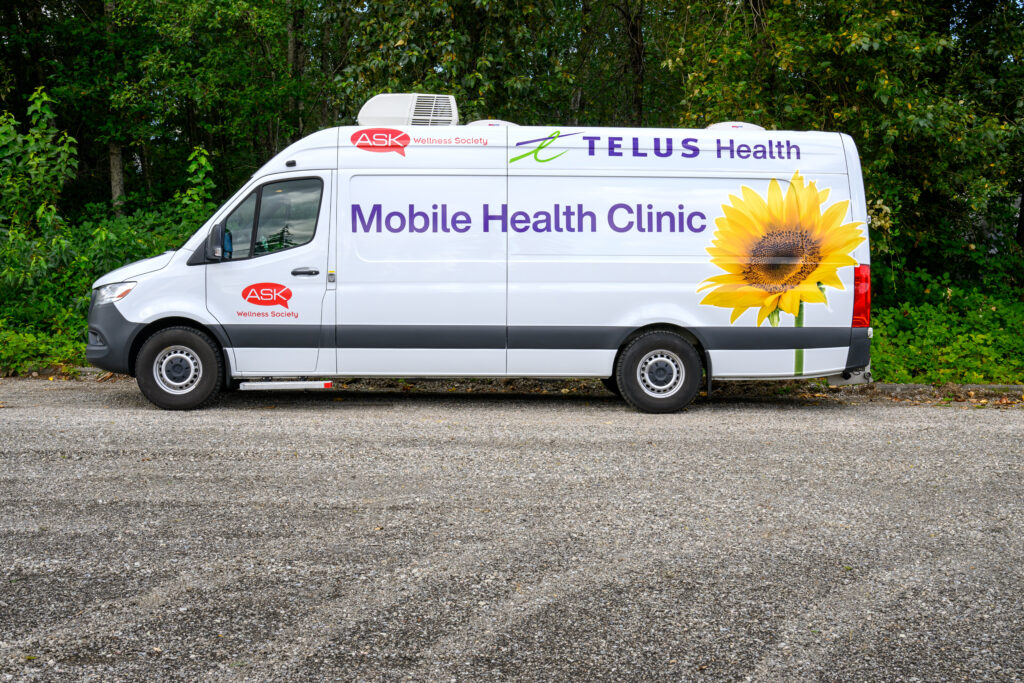
Ask Wellness and Telus health came together to combat this issue of homeless people needing basic medical attention crowding the emergency room and created this 90- square foot mobile clinic that will bring much needed care to the population that is struggling. Ask Wellness is an organization that since the 90’s has been providing outreach, housing, health, education, and employment services for marginalized people and those at risk in the community. As per the director of communications from ASK wellness, Andrina Tenisci, when asked if there was a turning point that they realized there needed to be a real solution and support Andrina said that “The need for this service is extremely apparent and the clinic has already been able to support many individuals who are willing to accept the help”. This is a very relevant story in Kamloops as the most pressing social issue for many years has been the growing homeless population. Additionally, this is a very timely story, this new program just got up and running on the 18th of September. This is a very important social project, but of course a major question remains, how much does this all cost and who is funding this project? In a press release provided by Andrina, it reveals that Telus health has committed $16 million through 2027 to fund Telus health projects. As this project directly serves the unhoused population of Kamloops, it is vital to know how that community has responded to this initiative. Tenisci said “For some people, there may be initial hesitation, so initiating casual conversation with a non-judgmental approach helps to build trust”.Another big question is how people who need help are going to know where the van is going to be and when, she responded that there is a tentative schedule in place as of now and they “will be assessing areas and locations where the need is most apparent. The clinic operates throughout the work week, Monday to Friday between 9am and 4pm”. As well as the schedule will changed based off community need. This is potentially life changing for many people who are living in less fortunate situations, the kind of care being provided in these vans “include referrals, connections to prescriptions, harm reduction, and wound care”. With the substantial amount of unhoused people living on the streets of Kamloops, there was a pressing question of how many units is there demand for? And is there plans to get more of these units on the streets of Kamloops, Andrina stated that this unit if the first of its kind in Kamloops, the third in BC and only one of thirteen across Canada. As this is still a relatively small program, this is an incredible step for Kamloops.
An initiative such as this in a city such as Kamloops, is a very strong step in the right direction to addressing the many social issues that are apparent and impactful to Kamloops residents every day. This is in no way going to completely combat all the emergency room overcrowding or fatal overdoses that very unfortunately happen over the city, however any positive change or step in the right direction for social issues is a win for so many people in need and for those who are constantly affected by the repercussions. Regarding repercussions of the overcrowding at Royal Inland, it does not just effect everyone who needs care and to see a doctor, but it also effects the Doctors and Nurses who are overworked in result of this. Organizations like ASK Wellness and large corporations such as Telus Health who have the mission to provide support to those in need in every possible way, such as Financial, emotional, and healthcare, with the right leadership and funding, are going to be the predominate reason for significant social change in our community.
Ask Wellness. (2024). Ask Wellness Society and TELUS revolutionize healthcare access in Kamloops with a state-of-the-art mobile clinic. Ask Wellness. https://askwellness.ca/ask-wellness-society-and-telus-revolutionize-healthcare-access-in-kamloops-with-a-state-of-the-art-mobile-clinic/
Radio NL. (2024, September 18). Mobile health clinic brings care to Kamloops residents. https://www.radionl.com/2024/09/18/122408/
Newswire. (2024). TELUS and Ask Wellness Society bring innovative Health for Good mobile clinic to Kamloops and Merritt. https://www.newswire.ca/news-releases/telus-and-ask-wellness-society-bring-innovative-health-for-good-mobile-clinic-to-kamloops-and-merritt-865577447.html
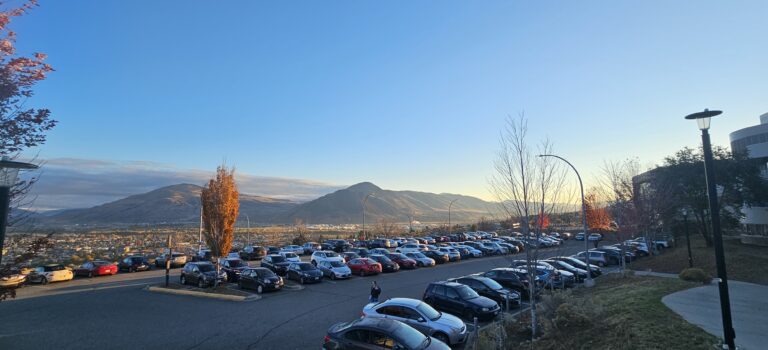
Ongoing Parking Issues at TRU
Parking at TRU has been a sore topic for most students at the university. Between the few parking lots and the pricing of parking passes, students aren’t happy with the situation. The school only has 4 parking lots reasonably close to the main buildings, split up as 2 general parking lots, and 2 economy lots. General parking also includes parking for students living on campus. One of the general lots is not paved, which potentially leads to a loss of parking space, depending on how close the cars are parked together. Asking one student, DJ, their thoughts on the parking situation at TRU, they had one thought overall: “Horrible”.
TRU has tried to push students to try alternatives to driving, such as biking or taking public transportation. The problem with alternative transportation such as these is that most students don’t live near enough to the university for these alternatives to be viable. When asked about these alternatives, the two students interviewed said they must arrive at school early to secure a parking spot, and if they took public transportation they would have to leave even earlier to get to school at the same time. DJ said they must get to school by 8 am to get a parking spot for their class at 10 am. Another student, Teegan, brought up the point that if they didn’t get a spot in a general lot, they would have to park in the back of an economy lot and run to class.
Parking spaces in the main lots fill up fast. A lot could be nearly empty around 7:30 am, and by 8 am, the lot is completely full, with students circling the lots hoping for any space. After 8 am, on most days, there will be a lineup of cars waiting to get into the main economy parking lot, Lot N. This lot is the largest on campus, but also the furthest away from any of the main buildings. If a student is unlucky enough to only find a spot at the back of the lot, they are in for a long walk to campus.
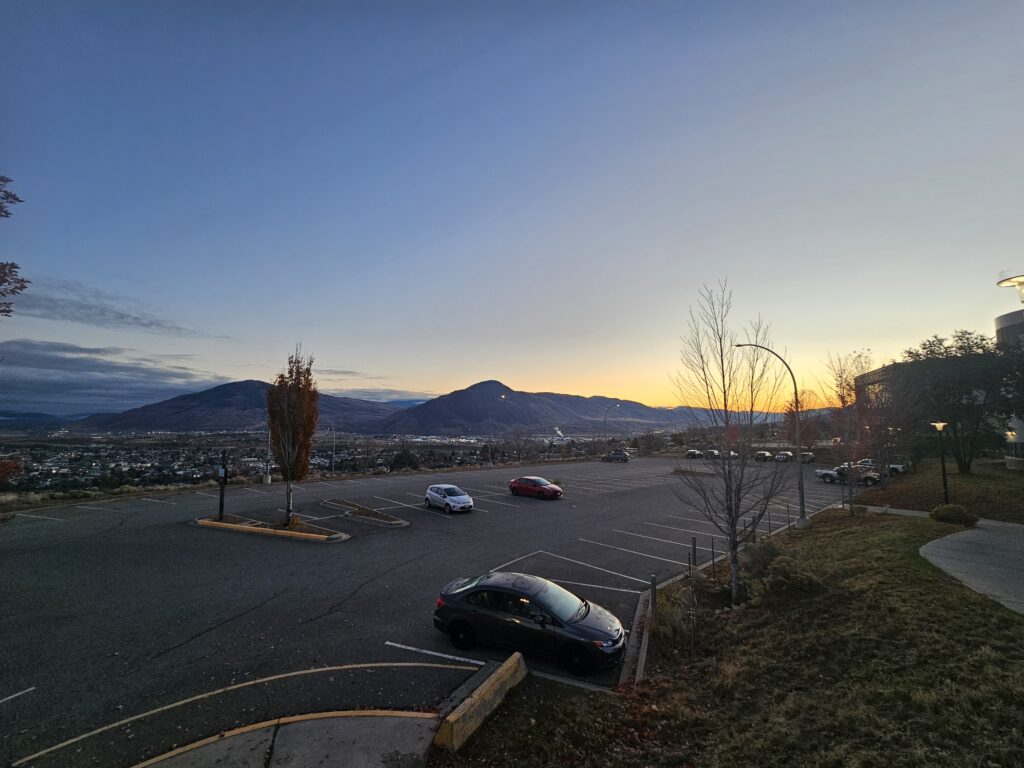
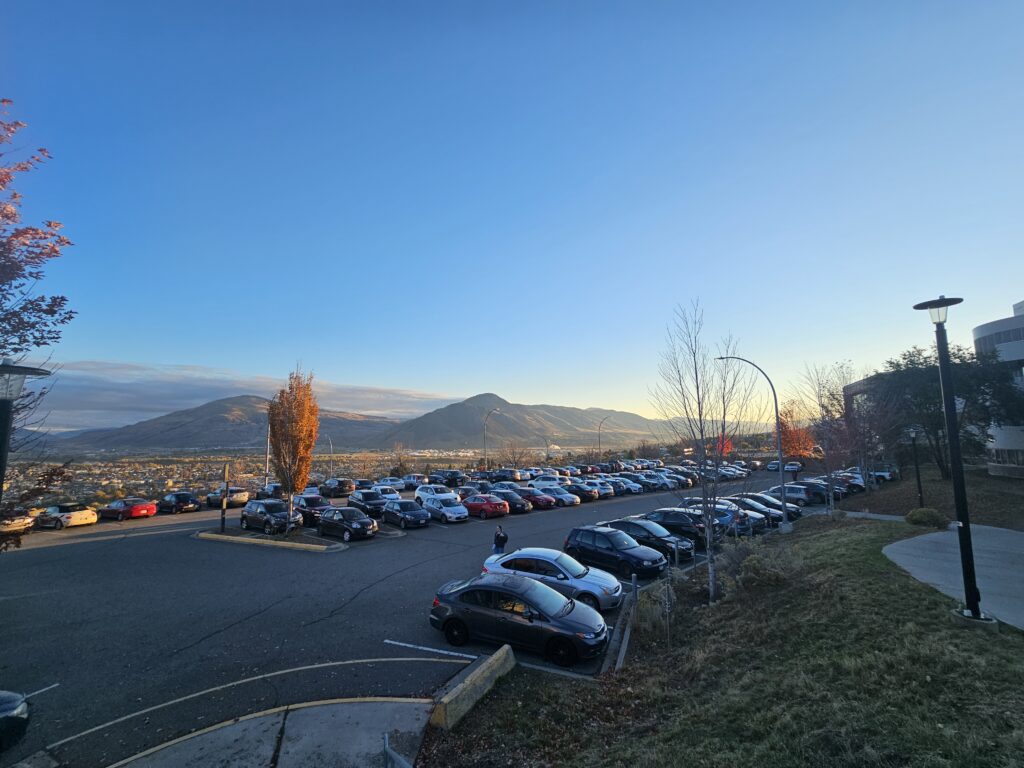
There is also an option for premium and reserved parking, but the only way to get these passes is by lottery. The pricing on these spots is over $70/mo. for premium, and $1200/year for reserved parking. Having a premium parking pass also does not guarantee a spot will be available either. While students with premium passes also have access to the general and economy lots, having the option defeats the purpose of having a premium pass in the first place. Pricing on the economy and general lots isn’t much better at ~$50 and ~$60 per month respectively. Paying any of these prices, especially as students are already paying tuition, books, rent, and groceries, among other expenses, puts a strain on students’ financial situations. For international students, the financial burden is even greater. There is a rebate for students outside of public transit areas, but the process for getting the rebate is not very clear. Another point of note about the general lots is that they are also available for day passes. While this is a great idea in theory, in practice it means that those who purchased passes for these lots often lose out on spaces to people who only purchased a day pass. Interestingly, visitor lots only sell parking in half-hour increments. Perhaps the visitor lots should sell day passes as well, surely there are some visitors who may need a whole day of parking. Doing this would relieve at least some of the pressure on the general lots.
Regarding alternative forms of transportation, public transit is generally unreliable early in the morning and later in the evening. This is especially noticeable during the winter months when buses can be delayed due to the weather. There are times when buses will just not show up entirely and students will need to wait until the next potential time a bus is supposed to arrive. This is a huge inconvenience for students who may not have any other choice for transportation and is a topic for another story.
Unfortunately, due to where the university is located, there are not many areas for expansion of parking lots. The alternatives proposed by the university are also unrealistic for most students because they often live further away from school, and those who can drive will not want to take public transportation if they can avoid it. This issue is ongoing, and there needs to be a review of how parking is handled at TRU and potentially revisiting how the lots are organized.
Truth and reconciliation. How can community members get involved and be educated?
TRU faculty member Elder Joanne Brown speaks of her experiences as an indigenous woman and how the community can get involved.
Samantha Jo Haire – JOUR 3160 – Posted Oct. 22 | Last edited Oct. 22, 21:22 p.m. PDT
Elder Joanne Brown giving her talk on October 10th, 2024. Photo taken by Journalist Samantha Jo Haire.
May 27, 2021 marks the devastating day when Chief Rosanne Casimir announced the discovery of 215 unmarked burial sites of Indigenous youth in Kamloops. Falling every year on September 30th, community members are encouraged to wear orange to stand in solidarity to those who have lost their lives in the Indian Residential School System.
“This day is important. It is a day that engages all Canadians and the Indigenous will not be overlooked.” Says Elder Joanne Brown at a post-event interview conducted on Thursday, October 10th.
The 94 Calls to Action are requests created by the indigenous peoples to make that first step into reconciliation and ensuring that the Indian Residential Schools will never happen again. These calls focus on creating a safe and inclusive space for Indigenous youth and members while holding space for them to practice their culture. Community members must remain aware of the diversity not only within the country, but within Indigenous nations and recognize that they have a right to practice their traditions. These calls focus on work, youth rights, parental rights, and education.
“Look at these 94 calls to action. Speak about them and learn from them” says Elder Brown.
1493 was the year that people discovered lands outside of Europe. When traveling to Turtle Island, known now as North America, the Christian Church had decided to implement a “papal bull” to show that the church now owns this land. Papal bulls are letters written by the pope when the European empires were colonizing different areas of the world. Any land that was not deemed as Christian or under the Christian rule was free for the taking. As more Europeans came to Turtle Island, they brought different diseases and infections, leading to 95% of the Indigenous population being wiped out.
The lived experience of each Native individual will vary, but it is important to recognize the long history of battles, infections, and “schooling” that lead to a decrease in their population. At TRU, every course and degree is supposed to have incorporated Indigenous teachings or history in their material. Whether it be understanding the chemistry behind the use of a clay oven, or an entire chapter based on traditions, TRU must keep the traditions alive and aim for reconciliation.
“Every faculty has a mandate to put truth and reconciliation into their plans. If students notice it is missing, they must speak up” says Elder Brown.
Orange shirt day – September 30th – is a day of mourning and commemorating those who have experienced residential schools and spread awareness for truth and reconciliation. Before her first day at residential school, Phyllis Webstad had been given an orange shirt by her grandma. With the school’s intention of stripping the kids of their culture and identity, Webstad had her orange shirt taken from her. Each year on September 30th, Canadians wear orange for those who could not dress how they pleased and represent their culture. Orange Shirt Day is not a celebration or a holiday, it is a day to stand with the Indigenous folks and unite with them. This day is to push community members to learn and understand the lived experiences of the natives and strive towards reconciliation.
On September 30th, 2024, Thompson Rivers University hosted an Orange Shirt Day event consisting of traditional singing, ribbon-skirt dance, language sharing, and much more. At the end, students, staff and community members gathered for a friendship circle: a circle created for song, dance, and connecting with those around them. This event had many shared practices and provided community members with a space to learn, unlearn and educate.
Elder Joanne Brown hosted a seminar on October 10th to discuss Truth and Reconciliation. Students, staff and community members gathered in the Brown House of Learning room 190 to hear her impactful speech. This room is sacred as it represents the traditional housing of the Secwepémc peoples and is structured in the same manner. Her seminar touched on her lived experiences of rekindling with family, seeing her family go through the residential school system, and the horrors she had seen throughout her lifetime.
Elder Joanne Brown and her daughter presenting a photo of Elder Brown and her family member on October 10th, 2024. Photo taken by journalist Samantha Jo Haire.
“A lived experience I wish to share is what happened to my siblings and the residential school.” said Elder Brown in the post seminar interview.
Elder Brown had spoken about the loss of her siblings through the residential school. From mental health problems to substance abuse, her family had endured great pain that was implicated by the residential school staff. She had lost many of her cousins, aunts, uncles, even her own siblings to the trauma from this school. Her story resonated with many who attended her seminar and discussions arose regarding other Indigenous peoples experiences.
It is important for community members to engage with Indigenous activities and learn about their culture. The first step to Reconciliation is acknowledging the wrong doings and understanding the pain. It is important to speak up when situations are wrong and be involved with the community. Truth and Reconciliation is important everyday, not solely on September 30th.
Communications and Journalism Club Kicks Off the Semester with Fun and New Opportunities for Students
TRU Club season has begun and a number of clubs were at the Club Fair in September; among them the Communications and Journalism club. The clubs are an important part of the TRU experience, however, there are still many students not yet part of any club missing on becoming part of their TRU community. As one of the newest clubs, the Communications and Journalism club held its first meeting on October 3rd and has plans for more events throughout the semester, offering just a glimpse of how campus clubs help keep students engaged and connected.
Thompson Rivers University’s clubs have started as the semester gets going, during September a number of different clubs were posted outside Old Main for students to join up with what best fits them. One of the newest clubs was among the posted clubs, the Communications and Journalism club; made for old and new students that are part of the communications or Journalism major to join in order to make friends, connect and have fun. Clubs are an integral part of the university experience all over the world, they allow students to find like minded people and create a community within their majors; this is no different here at Kamloops. Nevertheless, there are a number of students that have yet to take the step and join their destined club. In a recent interview: Aibiike Alymova the president of the Communications and Journalism club, discussed the importance of the club, their plans and more. During the interview it was revealed the origins of the club and how it became what we know now.
“So the journalism communications club originally started off as peer mentorship. It was a group of six people that we were peer mentoring for the program. Specifically when we started, it was Bachelor of Arts, majoring Communications, offering new media and PR, but we decided to expand more on our kind of field and get more people involved in it.”

The club is just at its beginning, it has a plethora of new ideas and activities for students that are eager to make friends and hangout with students with similar interests. The club is exploring the different activities that can be organized to engage students, such as a movie night featuring journalism related films. According to the club president, these activities can be a great way for students to spend an evening in Kamloops, especially if they’re looking for a fun different night. Clubs all over campus are not just “for fun”, but also to grow as a student and as a person, the Communications Clubs is no different as it allows members to grow and learn more about their major. Alymova emphasizes the advantages of clubs, by offering students valuable connections with other students and professionals:
“It’s mostly about networking because, for example, we have one of our alumni, Madeline. She works for the Chamber of Commerce. And just like the fact that younger students can chat to Madeline about how she started off her degree, and how she was going through her path.”
Aibiike Alymova explains how clubs such as the communication and journalism club also prioritize collaborating with professionals, in order to offer unique experiences for students:
“Last year we had, like an open class, because there was a class called decolonizing journalism, and people within, like an indigenous newspaper came in to speak, and our club got to collaborate with them, like they made it an open class for like anyone to drop in, drop out, not even like the people who are participating in the class. So also, we have Jennifer Kramka, who is willing to give like talk to CBC Kamloops, to give us, like a tour around CBC Kamloops, so that’s how we’re collaborating with professionals for now.”
Students all over campus new and old, are still doubting on joining their respective clubs or just joining something that interests them. Students are missing out on finding a group of like minded individuals, taking the leap of faith and joining a club in their university that best suits them. Joining clubs during university years yields great advantages for students and their experience during their time away from home, it offers students opportunities for networking, personal growth, and collaboration on exciting projects. Here’s what Alymova had to say for students having second thoughts:
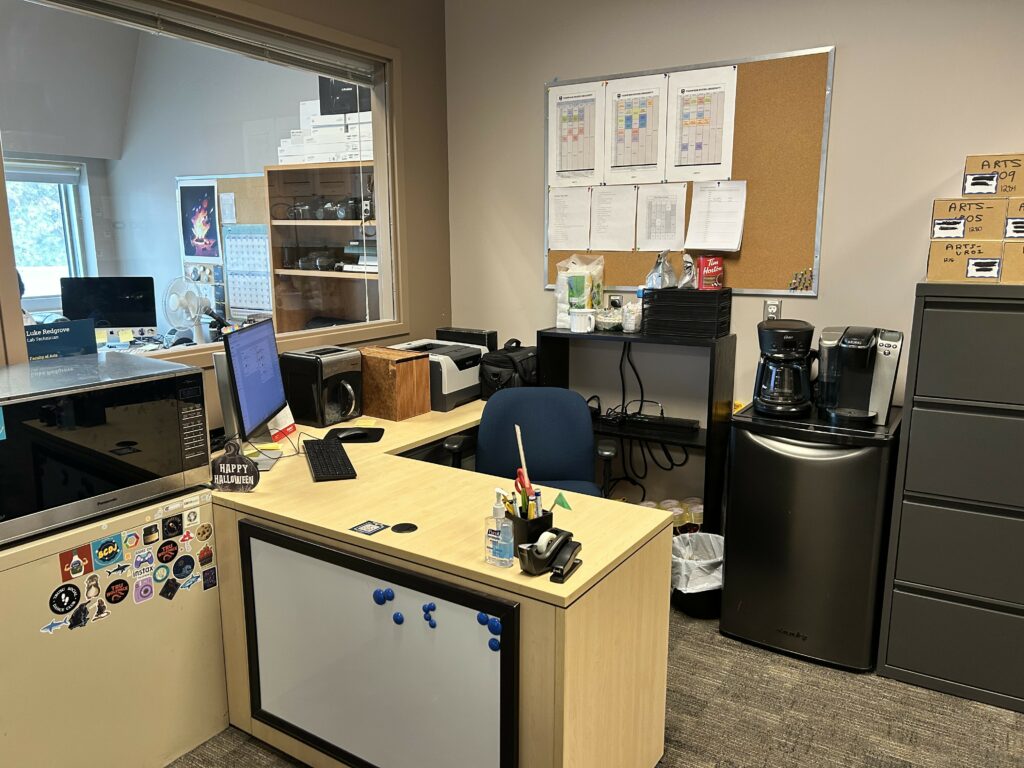
“If you’re not sure about joining it, try attending one of our like events or meetings, if you like it. We’re always looking forward towards new people. But I want to say that it is a great opportunity, because I don’t think that the journalism and communications department is that big, and it’s very important to like, know people within your degree.”
Clubs are an amazing opportunity to meet new people, find activities that interest you and find opportunities within your major or just something that interests you. TRU is filled with clubs that can help students find friends, network and have fun. The Communications club isn’t the only club available, there are clubs for Computer Science students, Anime Club, Latin Club and more. Each filled with similar members that will welcome anyone willing to join.
Kamloops officials tackle the rise of homeless encampments along the riverbanks

The city council and DFO collaborate to address public safety concerns related to fire risks and environmental issues as the number of encampments near Kamloops riverbanks increases.
The Kamloops riverbanks have recently been turned into the land of homeless encampments. Since it is a safe place to build up the camps, especially at night, riverbanks have become a zone for people without shelter in Kamloops. Authorities have intervened to remove the camps due to environmental and social issues concerning the safety and use of public space for the nearby residents and businesses. “There is a policy that the city has approved that allows for temporary overnight sheltering. So, they can go and set up a camp overnight, but it has to be taken down during the day, and it can’t become permanent,” Kamloops fire chief Ken Uzeloc said. He said the issue is that people generally fix a camp, which eventually becomes a permanent fix. “The rise of homeless encampments has been happening for a number of years, and it really stems from the lack of affordable housing,” Uzeloc said. Furthermore, he mentioned that at this point, the city council has identified 440 individuals as homeless. Meanwhile, the city council has just over 200 shelter beds available, and they have seen an increase in the number of homeless people year over year.
From the fire enforcement perspective, the he declares that when it’s getting cold and insufficient places, they see people in the camps trying to light fires to stay warm, “We’ve seen them where they’ll use hand sanitizer to light it on fire to stay warm as well; these aren’t necessarily great situations because they’re next to tents or flammable, combustible materials, and there’s been an increase in the number of burning complaints or outside fires that we’ve seen in the last couple of years, which is related to our vulnerable population.” fire chief Ken Uzeloc said.
The Kamloops Emergency Management Division works with social agencies and city housing groups to prepare for the upcoming cold-weather shelters and emergencies. “We look at operating the old yacht club into a winter shelter and then coming up with plans for when the temperature drops below minus ten as per the provincial guidelines and get more people off the riverbanks,” Uzeloc said.
Schubert Drive resident Joshep Carroll says the neighbourhood doesn’t feel safe walking and is worried about his family’s safety. “Back then, riverbanks used to be a peaceful place where we enjoyed our evening with families. But now it become a full land of encampments and a lot of litter around the riverbank and streets. It is really scarily unsafe to walk at night because some people are shouting and fighting on the street.” However, the chief Uzeloc said that just because someone has an encampment doesn’t necessarily mean a risk to the population or the neighbourhood. During the interview, the fire chief mentioned that the city council community service division actively monitors the community activities and concerns that may arise in the community. Also, if there is a criminal act or violent case near the encampment area, the Royal Canadian Mounted Police (RCMP) stands prepared for their duties to ensure the public safety of Kamloops residents.

Beyond public safety and social concerns, the encampments have major impacts on environmental issues, including harming fish habitats,which have raised the attention of the Department of Fisheries and Oceans (DFO) and Kamloops City Council.
Mainly, the temporary and permanent encampments may disturb the natural ecosystem, and the water pollution due to littering, including human waste, garbage, and chemicals, harms the aquatic habitats, affecting the water quality and fish reproduction. The major concern of DFO is that this Kamloops riverbank encampment results in the removal and damage of riparian riverbank vegetation, which is essential for fish habitats. The Vancouver DFO media officer Mo Qutob said that under the Fisheries Act’s fish and fish habitat protection provisions, they have the right to work with the groups to prevent or reduce harm to the fish habitats. “DFO has had multiple conversations with the Kamloops city council regarding the removal of riparian habitat due to riverbank encampments and general dike maintenance activities along the Thompson Rivers. We notified the city that the removal of riparian habitat at the proposed scale would require a Fisheries Act Authorization from DFO.” He said DFO habitat experts momentarily continue to work with the relevant authorities and the Kamloops City Council to finalize their request for approval on the proposed vegetation removal work.
(All pictures taken by Randi Chandrasekara October 8, 2024 – 4:00 PM @ Schubert Drive)
BC Wildfire Service Integrates Night Vision Imaging System into Fire Suppression and Response
The BC Wildfire Service (BCWS) integrated night vision technology into fire suppression operations for the first time during the 2024 season. This advancement allows the organization to conduct aerial operation objectives on a 24-hour scale, ensuring a more effective and efficient wildfire response.
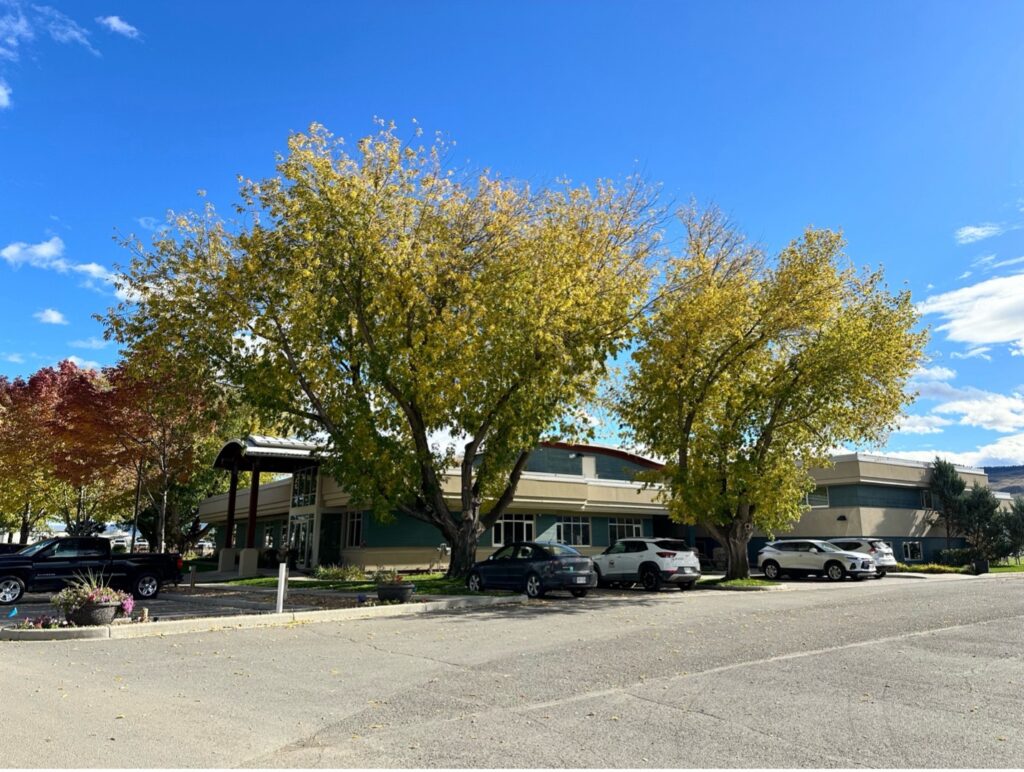
The province of British Columbia has seen severe impacts from annual wildfire seasons. The area of the Thompson-Okanagan area can be particularly vulnerable with hot and dry weather bringing temperatures reaching 35-40°C (Zussman, 2024). These extreme conditions pose challenges during wildfire season as there is a higher risk of ignition. “This was the first season we looked to fully integrate night vision operations into our daily operations,” says Jarrett Lum, BCWS Aviation Specialist during an interview at the Provincial Wildfire Coordination Centre in Kamloops on October 4, 2024. Lum explained that this technology consists of Night Vision Goggles (NVG), a form of Night Vision Imaging System (NVIS). “The goggles can amplify light up to 60,000 times,” allowing light detection from miles away said Lum. Traditionally, the BCWS performs ground crew and heavy equipment operations at night, however, aircraft were required to ground after legal daylight under Visual Flight Rules. By integrating night vision technology into wildfire response, the organization can extend hours of aerial operations.
This season, BCWS deployed two aircrafts equipped for night vision flights. The two helicopters are modified to reduce the internal cockpit light to not interfere with the NVG devices, and they are equipped with a steerable searchlight to navigate terrain. Lum noted that the first aircraft was primarily utilized for observing, reconnaissance, and detection, flying 31 missions during its contract between July 11 and August 28. The second, helicopter, equipped with a helitanking system, performed 14 tanking missions during its contract from August 1-28, recorded Lum. He explained this system, with a water tank attached to the belly of the helicopter, is used because the limited field of view and depth perception can pose hazards when dealing with a long-line bucketing system in challenging terrain. Stationed in Penticton, these helicopters collectively flew 171.1 hours at night from Jul 11 to August 28 in the Kamloops Fire Centre and the Southeast Fire Centre stated Lum. They actioned several wildfires, including the Shetland Creek wildfire (K70910), and contributed to the detection of 24 new starts.
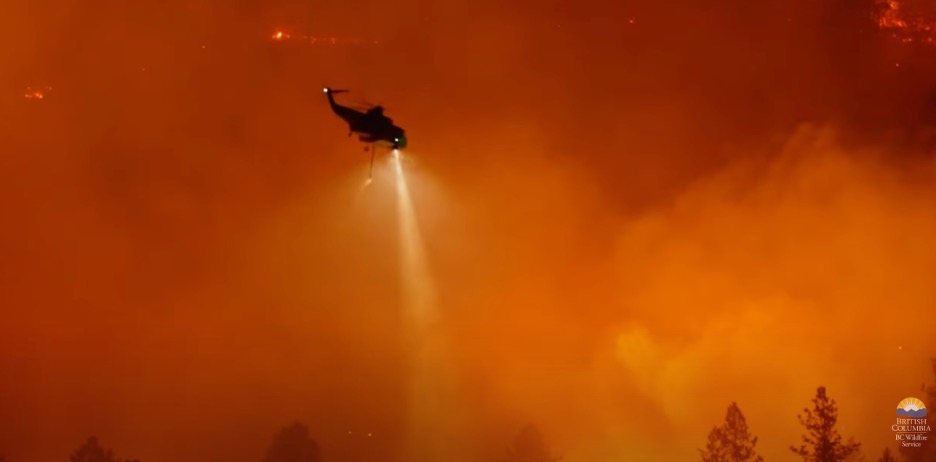
The success of these night vision operations is closely tied to the skill and knowledge of the personnel involved. Lum explained that each aircraft flies with one or two advance NVIS-certified pilots and a BCWS Trained Observer to coordinate operations. The helicopter pilots hired by the BCWS are each highly trained and have experience with wildfire and mountainous terrain. Lum stated the training for BCWS Trained NVG Observers is outsourced where personnel complete three days of ground school, three nights of flying, and a test. This specialized training allows the BCWS Trained NVG Observers to work with coordination centres and ground crews, providing information for wildfire operations.
The night vision goggles have proven to be a valuable resource for detection and reconnaissance, being the eyes in the sky for crews on the ground. The BCWS NVG Trained Observers work with fire centres and ground personnel to help “assess fires, their growth, their behaviour, their distance to values at risk, find access points, … and effectively [position resources]” said Lum. Because the goggles allow a high degree of amplified light, small fires can be found more easily at night. Bryce Moreira, BCWS Aviation Preparedness Officer explains they can utilize this technology to “assess where lightning strikes have started new incidents” (BC Wildfire Service, 1:45). The Government of British Columbia records over 60% of wildfires are lightning and naturally caused (Government of British Columbia, 2023). Lum stated that because of the “decrease in temperature and an increase in relative humidity, the water [tanking] can be more effective at night.” During the evening, fire activity is significantly lower and is more susceptible to suppression efforts. The NVG technology is providing several advantages for wildland firefighting.
With the many advantages of NVG, come certain challenges. Lum explained that the goggles only allow a 40°field of view as opposed to 200° view of the naked eye. This requires constant scanning of the personnel’s surroundings. There are several considerations to be made when working with 24-hour aerial operations. Operational staff and dispatchers in fire centres, fuel, water, and pilots can be limited resources that are required to support the work of NVG helicopters and personnel, and must be balanced during the day and at night explained Lum.

The BC Wildfire Service will spend time in the winter months reflecting on the successes and challenges faced during the first season of using NVG technology and will look to make adaptions for future success accordingly, said Lum. He mentions that the organization is looking to equip additional helicopters with NVG capabilities as well as increase personnel to support the NVG resources. When asked if there was anything Lum would like to share with the public about NVG technology for wildfire suppression, Lum said, “[it’s] a very interesting and valuable tool that we are continuing to learn about.” As the organization continues to explore the full potential of the NVG technology, it is clear it will play an increasingly important role in wildfire suppression in British Columbia.
References
BC Wildfire Service. (2024, August 21). How we use night vision technology. BC Wildfire Service. https://www.youtube.com/watch?v=YImFW6UtE4o
Government of British Columbia. (May 18, 2023). What causes wildfire? Government of British Columbia. https://www2.gov.bc.ca/gov/content/safety/wildfire-status/wildfire-response/what-causes-wildfire
Lum, Jarrett. (October 4, 2024). Personal Communication.
Nessman, Cali. (October 4, 2024). Provincial Wildfire Coordination Centre [Photo].
Zussman, R. (2024, October 11). B.C. sees record-breaking temperatures during unusual fall heat wave. Global News. https://globalnews.ca/news/10614349/bc-heat-wave/
A CANDLE OF HOPE: HOW KAMLOOPS’ VAM CLINIC IS CHANGING ADDICTION TREATMENT
As Kamloops grapples with an increasing wave of drug-related deaths, how is the VAM Clinic altering access to addiction treatment?
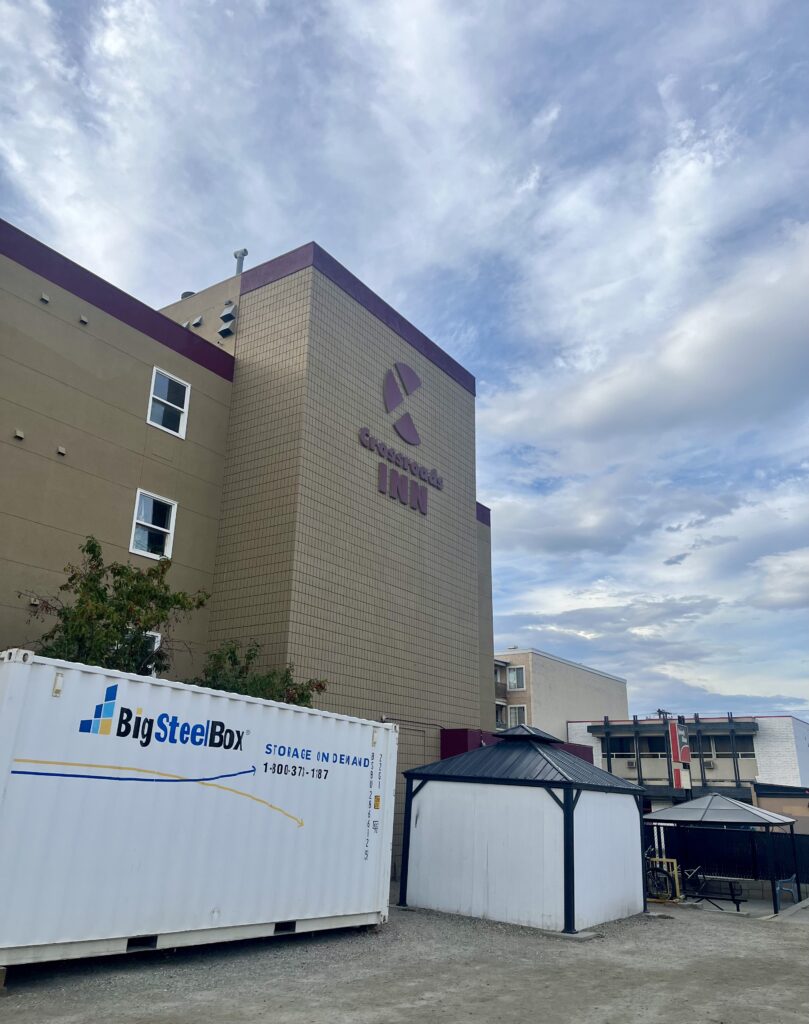
A quiet revolution in addiction treatment is taking place deep in British Columbia’s interior. Interior Health’s Virtual Addiction Medicine (VAM) Clinic’s innovative self-referral option has provided a lifeline for Kamloops people struggling with alcohol or opioid addiction. This groundbreaking service, launched in September 2024, avoids current obstacles to treatment, allowing individuals to seek help directly through a simple online form. For a community dealing with the ongoing dangerous drug crisis, this digital gateway to treatment is more than convenience; it’s a possible lifesaver, providing hope and fast access to specialised care when every instant counts.
The opioid crisis has thrown a long shadow on Kamloops, with overdose deaths up 140% between 2019 and 2020. In 2019, the city mourned the deaths of 25 people; by 2020, the figure had risen to 60. This alarming trend continued, with 2022 being the bloodiest year for drug-related deaths. The pandemic worsened the problem, as indicated by BC Emergency Health Services records, which show a 56% rise in overdose-related calls in the Interior Health region from 1,332 in 2019 to 2,077 in 2020.
During a recent news conference, Dr. Carol Fenton, a medical health officer of Interior Health, emphasised the gravity of the crisis, saying, “The hazardous drug supply is killing our friends, family members, and neighbours at an unprecedented rate. We’re dealing with a poisoning epidemic, not an addiction crisis.”
The self-referral process at the Virtual Addiction Medicine (VAM) Clinic is changing the way Kamloops residents get addiction treatment. Unlike the former system, which required physician referrals, patients can now request appointments directly through a simple online form at interiorhealth.ca/vam. Dr. Todd Thexton, Medical Lead for the VAM Clinic, stated in a press conference, “We have streamlined the procedure to assure a quick response. Typically, a clinician calls the applicant within one business day to set up a phone or video appointment.” This digitally driven approach not only shortens wait times, but also provides greater privacy and flexibility. The VAM team then works with clients to create personalised treatment regimens such as opioid agonist medication.
Building on the VAM Clinic approach, the social impact of this new system is clearly demonstrated via the experiences of those it seeks to assist. During a recent interview at the Crossroads ASK Wellness facility in Kamloops, I chatted with James, a 45-year-old Kamloops resident who has fought heroin addiction for two decades. James, who was unaware of the VAM program prior to our chat, exhibited cautious hope when we discussed the self-referral option. “It’s as if they’re meeting us exactly where we are, you know? There are no judgements or hoops to jump through. “Just help when you need it,” he continued, his voice full of optimism.
James’s tale is not unique; it is part of a broader storyline unfolding throughout Kamloops. The VAM Clinic’s self-referral system was specifically developed for people like him, providing a lifeline when established channels have failed. For James, the potential of overcoming usual barriers was especially appealing. “I tried the system before, but it didn’t always work for me. “The idea of receiving a personalised treatment plan, possibly even medication to help with cravings or withdrawal, sounds like it could make a significant difference,” he added, emphasising the potential life-changing impact of the VAM Clinic’s user-centred approach.
Interior Health’s Virtual Addiction Medicine (VAM) Clinic has prompted an influx of reactions from Kamloops-based organisations dedicated to assisting vulnerable populations. The Canadian Mental Health Association’s Kamloops Branch, which supports over 1,300 people locally, sees the self-referral option as a huge step towards breaking down mental health stigmas. Alfred Achoba, Executive Director of CMHA Kamloops, remarked in a recent press release, “This virtual clinic aligns with our mission to create inclusive opportunities for individuals to thrive.” Similarly, the BC Association of Social Workers (BCASW) regards the VAM Clinic as an important tool for social workers to better help their clients.
ASK Wellness Society, a community-based organisation dedicated to combating homelessness and addiction in Kamloops, is in the forefront of this effort. Nick, a tenant support worker at ASK Wellness, shared his thoughts during our interview. “The VAM Clinic’s self-referral option is a game-changer for vulnerable populations,” Nick told me. “It removes major obstacles to accessing addiction treatment by allowing individuals to refer themselves without needing a doctor’s referral.” Nick did, however, outline potential implementation issues. “One of the primary challenges will be ensuring that everyone who needs this service is aware of it and understands how to use it,” according to him. “Many of the individuals we work with may not have regular access to the internet or technology needed for virtual consultations.” Despite these challenges, Nick is hopeful about the VAM Clinic’s potential impact, emphasising the significance of offering opportunities for individuals to get treatment when they need it the most.
As the Virtual Addiction Medicine (VAM) Clinic grows, its impact on Kamloops and the neighbouring areas grows. Dr. Todd Thexton, Medical Lead for the VAM Clinic, emphasised the program’s adaptability during a recent press conference, saying, “We’re always modifying our approach based on feedback from clients and community partners. Our goal is to make addiction treatment as accessible and efficient as feasible.” This dedication to progress is shown in the clinic’s efforts to integrate with the province-wide Opioid Treatment Access Line, which will simplify the process for those seeking assistance.
The establishment of the VAM Clinic’s self-referral option represents a big step forward in combating the current toxic drug crisis. For people like James and many others battling with addiction in Kamloops, this unique method provides not only therapy but also hope. As the community grapples with addiction issues, the VAM Clinic serves as a symbol of progress, providing critical tools and unwavering support that pave the way for recovery.
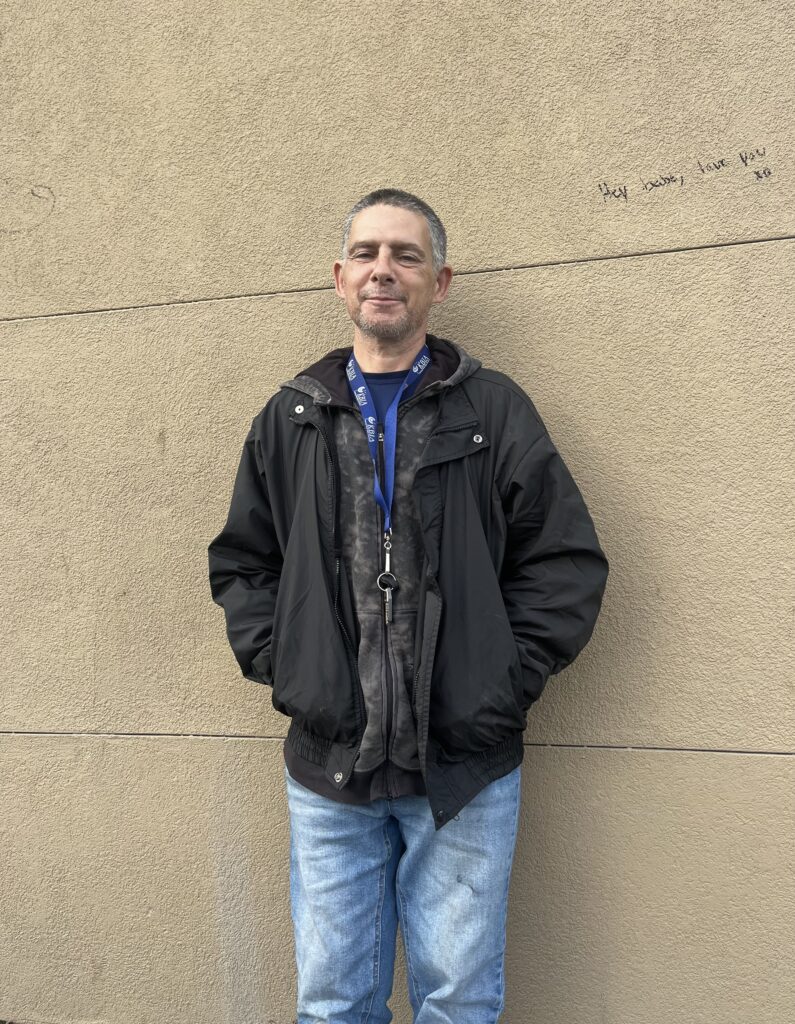
Citations
BC Coroners Service. (2024, August 31). Kamloops loses eight lives in July due to toxic drug crisis. CFJC Today. Retrieved from https://cfjctoday.com/2024/08/31/kamloops-loses-eight-lives-in-july-due-to-toxic-drug-crisis/
Interior Health. (n.d.). Virtual Addiction Medicine (VAM) Clinic. Retrieved from https://www.interiorhealth.ca/services/virtual-addiction-medicine-vam-clinic
Government of British Columbia. (2024, May 31). Expanded clinic will deliver more mental-health, addictions care for Vancouver’s Downtown Eastside. Retrieved from https://news.gov.bc.ca/releases/2024MMHA0028-000846
TELUS. (2024, September 18). TELUS and ASK Wellness Society bring innovative Health for Good mobile clinic to Kamloops and Merritt. Retrieved from https://www.telus.com/en/about/news-and-events/media-releases/TELUS-and-ASK-Wellness-Society-bring-innovative-Health-for-Good-mobile-clinic-to-Kamloops-and-Merritt
Canadian Mental Health Association Ontario. (n.d.). Getting help. Retrieved from https://ontario.cmha.ca/documents/getting-help/
The Annual Competitive Student Housing Hunt Continues in Kamloops, and Answers are needed
With every September becoming a battle for a living space, what are the logistics of the residences Kamloops has on its University campus?
A student housing crisis has been ensuing over the past couple years at Thompson Rivers University from the strong overflow of admissions, and answers are needed. Many student residents attending TRU have faced the same problem towards the end of summer and even the start of the year; not being able to find a bed to sleep on for 8 months. This is a problem that many students here in Kamloops have been demanding answers to for a long time. According to the TRU Fact book, there are 14,525 students on campus, and 1,472 beds for them to stay in on campus.
This very stressful situation only gets worse as the school year begins. Students find themselves having to couch surf for the first couple weeks of classes, and in some worse situations, renting hotel rooms by the night. Students expect an answer for this problem in the form of new residency, which they got the answer for; to an extent.
Coyote Den, a new residence near East Village that holds 80 rooms and 148 student beds. Standing as the newest, a singular room in this dormitory costs $10,000 for the whole year. A double costs each student $4,388. If a student is not able to find a roommate for this dormitory, they would be subject to essentially paying $1,250 a month. “I wish I could just live in a more mediocre apartment complex for a cheaper amount”, said a Coyote Den resident who chose to remain anonymous. Comparing this to a four-bedroom suite in McGill that fills up very quickly, those students would only be paying $6,075 which comes out to approximately $760 a month.
As students are being given a residence that provides many different amenities, and brand new furniture for a less affordable price, it seems like the residency planners are missing the mark. The doing of a new residence being created on campus is a step in the right direction, but being cognizant of the expenses needed, a student in need still needs a cheap living option. Quality is always needed, but quantity is a big and lacking factor on the campus.
Westgate was the second to last residence that has been paid for and built on campus. This was definitely created as the cheaper option out of all the residencies. Westgate was created as a temporary relief for students dealing with the issue at hand. With 114 self contained private rooms in trailer homes. Affording this option that also fills up very quickly would cost $5,380, which cut into monthly payments would equal $672 a month. This is a great example of the opposite of Coyote Den. The big picture revolves around TRU needing a happy middle ground for the students who are just in need of a comfortable space to stay in for up to 8 months. A quick interview with Olivia [last name remains anonymous], a housekeeper for Westgate, she claims that “Westgate is definitely smaller, but it is a trade off as I would say you get more privacy [than Coyote Den].”
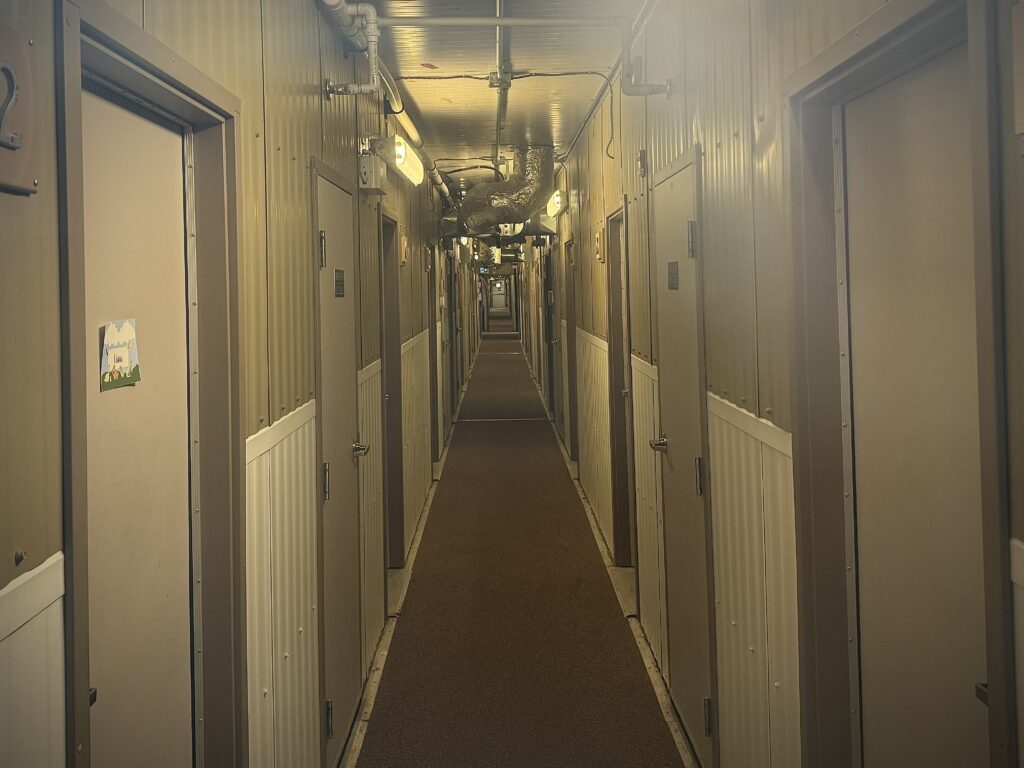
(Photo by Dermot Lonergan of Inside Westgate Dormitory hallway)
Being home to around 570 students around the year, North Tower is one of the more accommodating spots on campus, ranging from $9,100 a year for a two bedroom or four bedroom spot. This pricing comes out to around $1,137 a month. Even though over half a thousand students being able to stay in this residence seems like a fair amount, the competition is fierce when it comes to being selected to stay. But this does not just stand for North Tower, this is an all-residence type of problem. East Village holds up to a max of 510 students a year. To put this into perspective, the University of British Columbia has a residence called the Orchard Commons which holds over 1,000 students a year per building. As this is a wider scale of students attending UBC Vancouver, two of the biggest residence buildings equate to a singular residence.
For the price North Tower costs, there are some lacking amenities that are not up to par with other cheaper residences with less space. Jack Clayton of the TRU Men’s Basketball team, who lives in the residency, claims that “Some of the off campus housing is sometimes cheaper per month and you get way more space and closer stores and restaurants.” In the quick interview, he also said that a problem he had faced for the price paid was that “It was very difficult to get a spot in North Tower, and once I got in, I could not believe how small the kitchen and cooking area as a whole was.” North Tower staff declined any sort of comment at this time on the topic of “housing competitiveness”.

(Photo by Dermot Lonergan of outside North Tower, Kamloops BC)
As answers may take time to come for this steep problem, students do have hope in the fact that new residences are indeed being built; a happy medium between affordability and comfortability is ideal for these Kamloops students who travel away from home for the sole reason to expand their education.
Sources:
Thompson Rivers University. (n.d.). TRU Residence Services. Thompson Rivers University. Retrieved October 22, 2024, from https://www.tru.ca/housing.html
Thompson Rivers University. (n.d.). TRU Factbook. Thompson Rivers University. Retrieved October 22, 2024, from https://www.tru.ca/oirpa/factbook.html
The Terry Fox Run Returns to Kamloops Following Brief Hiatus
The Terry Fox Run returned to Riverside Park in Kamloops this year after being held virtually since 2020 due to the pandemic. On September 15th, families and friends came together once again to show their support for a foundation held close to many across the Country.
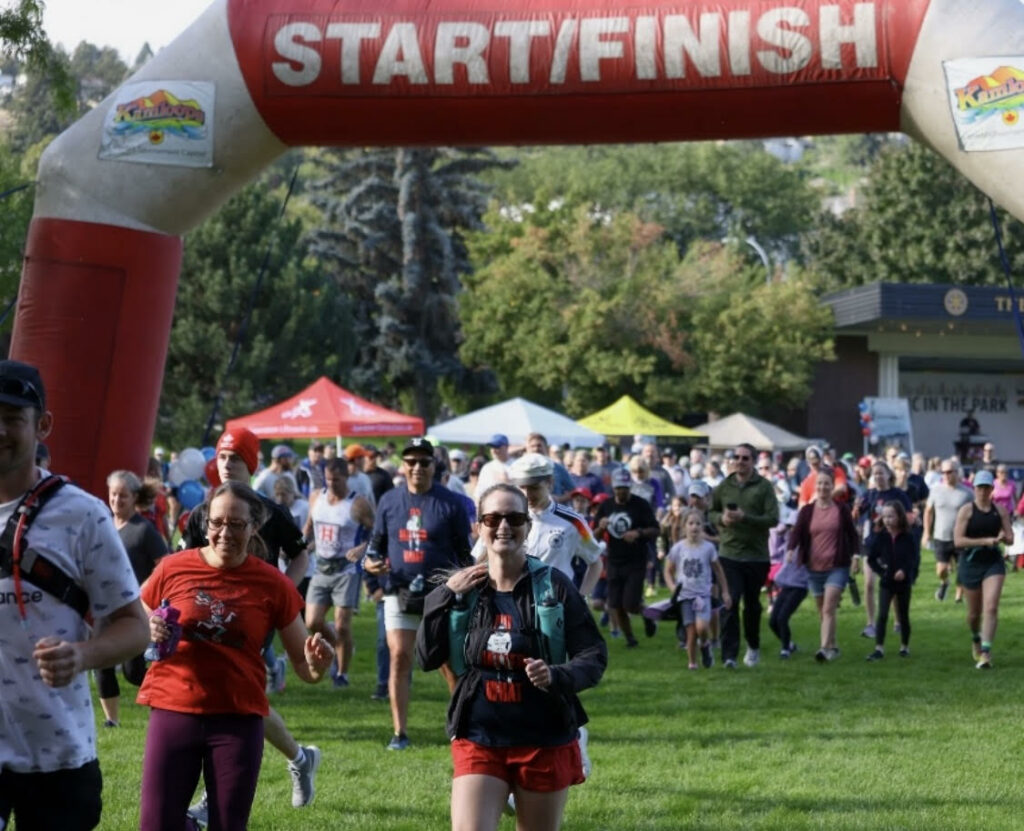
Since 1985 Kamloops has hosted organized community Runs in support of the Marathon of Hope Foundation that Terry Fox started 44 years ago when he lost his leg, and shortly after, his life, to cancer. The Run in Kamloops took a brief hiatus in 2020 and 2021 due to the pandemic. With many still hesitant to participate amongst large crowds of people, the Run was held virtually in 2022 as well. In 2023, due to lack of volunteers and organizers, the event was forced to fundraise online again. This year, with proper organizers and enough volunteers, the Terry Fox Run commenced once again bringing the community back together.
In an interview with Sue Steenson, one of the Run organizers this year, she mentions people were thrilled to have the feeling of community spirit back after the Run’s brief hiatus.
The Terry Fox Run is a fundraiser held close to Run organizer, Sue Steenson. Her inspiration and motivation to this cause dates back 44 years ago to when her mum was being treated for cancer at the same time Terry Fox started his Marathon of Hope. Steenson says her mother told her to “get her butt out there” and has participated in every Run she could since. Steenson adds that in her 40s she was diagnosed with cancer and thanks to the treatment from the research the foundation has done, is the reason that she is here now, and was able to raise her kids to adulthood. Steenson has also taught the Terry Fox Run in school to all of her classes as a teacher and has made sure everyone was involved and educated in its importance. Steenson comments that “bringing back this community event brings back the spirit of Terry Fox and the Marathon of Hope. The whole message is hope and the Run, brings back hope.”
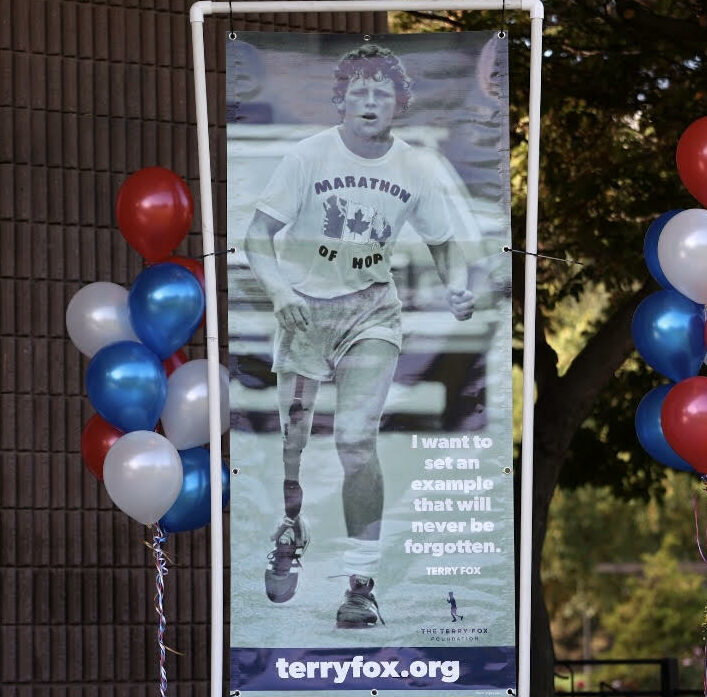
The Terry Fox Run is an important fundraiser across Canada, even with the Run’s hiatus due to Covid, the event was still deemed successful while being held virtually. In 2022, organizers tried to host the event, however only 96 participants volunteered. Even with fewer participants, the Run raised $25,280 for the Terry Fox Foundation. In 2023, the Run was left without any organizers and was forced to be held again virtually, however, even with no one organizing, and no actual Run held, the event still raised $11,775 towards the Foundation. Steenson mentions how even though this year the organizing of the Run started late, with little preparation time, they had 325 people participate, raising a total of $22,100.25. Steenson adds that the $4.25 cents was from a little girl that wished to remain anonymous.
In the interview with Sue Steenson, she reflects on the importance of continuing with the Run and educating young people on its history and importance. She states that, “Everyone’s life is touched by cancer, whether that be through a family member, friend or themselves who has dealt with the fear, sickness, and sometimes loss, that it brings. Terry Fox had a dream to replace some of that fear with hope. His vision was to support scientists and researchers with the funds they needed to learn new ways to deal with cancer, and his inspiration has made such a difference. In the 44 years of the Run continuing after he couldn’t finish, there has been significant improvements in diagnosis, treatment and outcomes for cancer patients. Chances of survival have gone up for some childhood cancers from 10-20% to 85-90%! Our young people need to know Terry’s story and understand the difference it makes if everyone contributes a little bit to support cancer research. We need the hope part of his Marathon of Hope to fight the pain and fear this disease causes. We need our younger generations to have role models like Terry Fox, to have actual examples of resilience and caring for others, to see what giving of yourself to your community can do in the world. While continuing to fund the innovative research that will one day end cancer”.
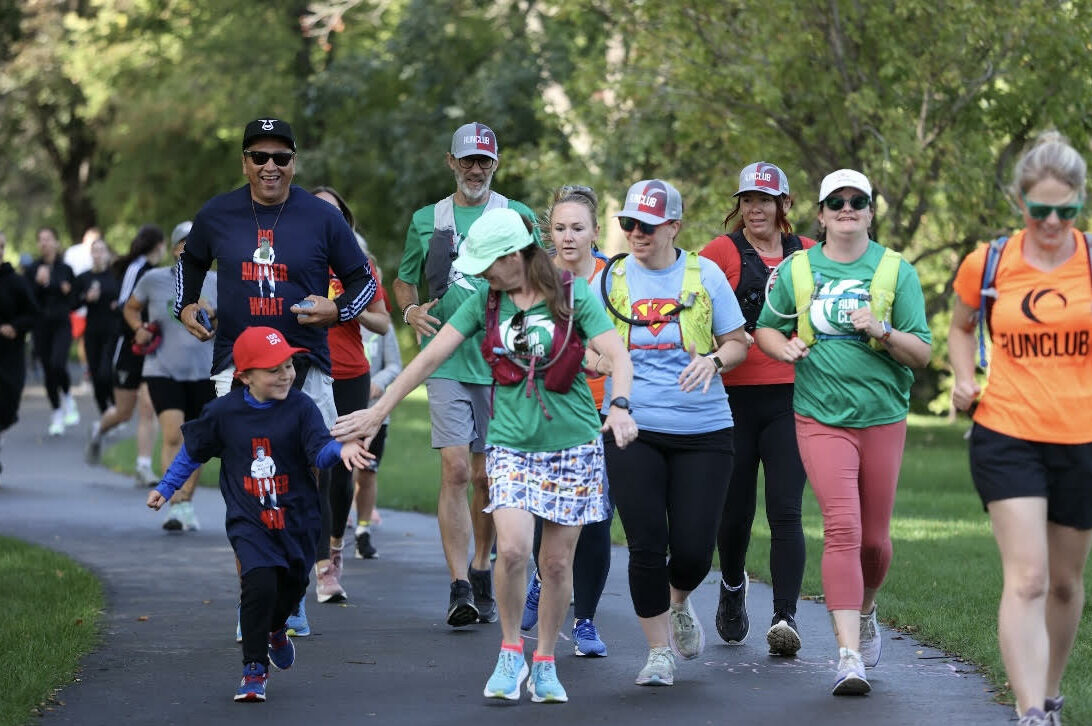
In terms of next year’s Run, Steenson says they have big plans for the fundraiser here in Kamloops. They are hoping to increase the number of corporate and workplace teams as well as getting small businesses involved in participating. Steenson notes that they are looking into some pre-events to promote on the day of the Run as well as a currently brainstorming for fun activities to incorporate for all ages at the park. The impromptu friends and family picnics afterwards gave Steenson some ideas as well for next year’s event. She also hopes to see an increase in fundraising next year, as previous years have seen a total of almost $50,000 raised. Steenson remarks how many participants commented on how good it felt to be doing something together once again, for a good cause.
This is a cause that helps everyone, and as Terry told us, $1 per person adds up pretty fast if everyone joins in.
Sources
All photo credits go to Sue Steenson ssteenson5@gmail.com
de Bruin, T. (2008, May 26). Terry Fox | The Canadian Encyclopedia. Thecanadianencyclopedia.ca. https://www.thecanadianencyclopedia.ca/en/article/terry-fox
Terry Fox Run returns to Kamloops Sunday morning. (2024, September 13). CFJC Today Kamloops. https://cfjctoday.com/2024/09/13/terry-fox-run-returns-to-kamloops-sunday-morning/
The Terry Fox Foundation. (2013). The Terry Fox Foundation – A single dream. A world of hope. The Terry Fox Foundation. https://terryfox.org/
Climate Change In The Secret Life Of Beekeepers.
Local Beekeeper explains how climate change is affecting beekeeping in Kamloops and surrounding areas, as well as what citizens can do to help save the bees.
“Over the last 75 years, bee populations have decreased over 50%, while human populations have increased by over 130%. Bees are responsible for commercial food production that powers modern cities and the world” (Save The Bees, n.d.). Climate change has not helped with this either as the constantly changing climate, bees are no longer following their normal routine.
Oliver Taylor, a second generation beekeeper, and his wife Beth Taylor explained how climate change is affecting beekeeping as well as what it’s doing to bees.
Oliver is a hobby beekeeper (as pictured to the right), which focuses on beekeeping as a passion instead of for a profit. Most hobby beekeepers, like Oliver, work with honey bees instead of bumble bees, mason bees or solitary bees as honey bees are the easiest to obtain and work well in larger groups.
Oliver started off by talking about how the climate has been affecting bees and beekeeping. “Either last winter or the winter before, it was really warm all the way into December, so what happened was bees didn’t cluster. So they were still spaced out within the hive and the queen’s still producing eggs and then it suddenly got cold.” he stated.
“They used up their winter supply in the first two weeks, leaving nothing to keep them alive or warm, leading to the death of the hive.,” Beth adds.
“That’s one thing with climate change. The other one would be super hot summers, and the smoke too since they don’t like smoke. Because they need super specific conditions to fly in, smoke seems to trigger them not to want to fly to go collect pollen Which then leads to low baby production, which then leads to the death of the hive.”
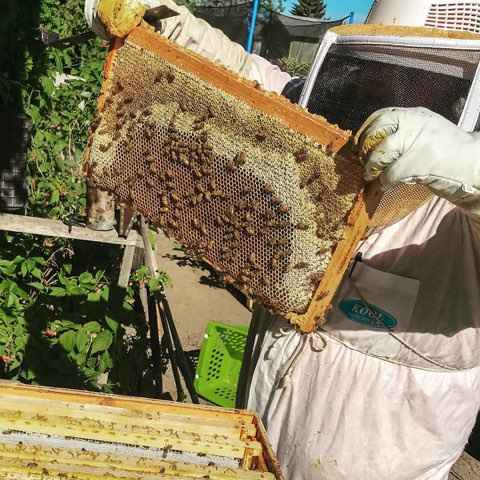
Oliver said due to recent wildfires, many bees have left the area in search of safer environments.. “Most of the valley bottom bees would’ve gone higher to get out of the smoke.”
“As a beekeeper, you’re reliant on the weather, but you also have to be kind of a fortune teller to figure out, ‘yeah it’s warm right now but are we going to get a frost?’” Beth adds.
Oliver says, “beekeeping, like any kind of agricultural thing, is not looking at today. Today you’re working. But what you do today affects you six months from now.”
With the save the bees campaign, we asked how they view the save the bees campaign and how it has affected his life as a beekeeper.
Oliver said at a farmers market he was told thank you, which he was confused by as he feels he has nothing to do with saving the bees.
“It’s not the happy go lucky of like ‘Oh, Save the Bees!’ Like beekeepers have so little to do with saving the bees. It’s much more that they are farmers” Beth says.
“But that’s where save the bees come into it. It’s not honey bees but local solitary bees or small group bees can weather these things better than managed hives can.” Oliver adds.

Oliver began talking about a study done in Japan where “they don’t have a ton of managed honey bees but they have some. Orchardists were supplementing by raising their own Mason bees and Solitary bees and they were finding that when they brought in the honey bees to pollinate most of the flowers were already pollinated because the Mason bees and the Solitary bees work at a cooler temperature than the honey bees.”
“They actually found it was more cost effective for the orchardist to raise their own honey bees because they operate better, work in cooler air, can go in wet air and they aren’t susceptible to some diseases within the honey bee population.”
“So like, save the bees vs like for beekeepers, saving the bees is like keeping beekeepers out of it essentially.”
Beth and Oliver say ways that people can help save the bees would be to watch what pesticides you use on your lawn or avoid it. Rake your leaves less as bees will use those for water and sources of heat during the winter seasons. You can even leave a plate of water with rocks so they can hydrate. Bees need to stand to drink so if they don’t have a shallow pool of water, they will drown.
You can also go to savethebees.com to search more ways to help save the bees.
Kamloops is a Bee City, which means they have special laws put in place for residents to own and have bees on their property. Learn more at www.kamloopsbeekeepers.com.
Beth says that the Kamloops beekeeper society will let local beekeepers know of any possible disease outbreaks in Kamloops. They also help with testing of it and being able to bring in your bees and test them for you to see if there were any outbreaks in your bee colony.
Sources:
Home. Kamloops Beekeepers. (2024, February 2). http://www.kamloopsbeekeepers.com/
Orchard pollination: Solitary (mason) bees. Penn State Extension. https://extension.psu.edu/orchard-pollination-solitary-mason-bees
Save The Bees – Supporting Beekeeping and Research. (n.d.). Save the Bees. https://savethebees.com/Biddinger, D. (n.d.).
This is a post. Category Finance.
Where does it go?